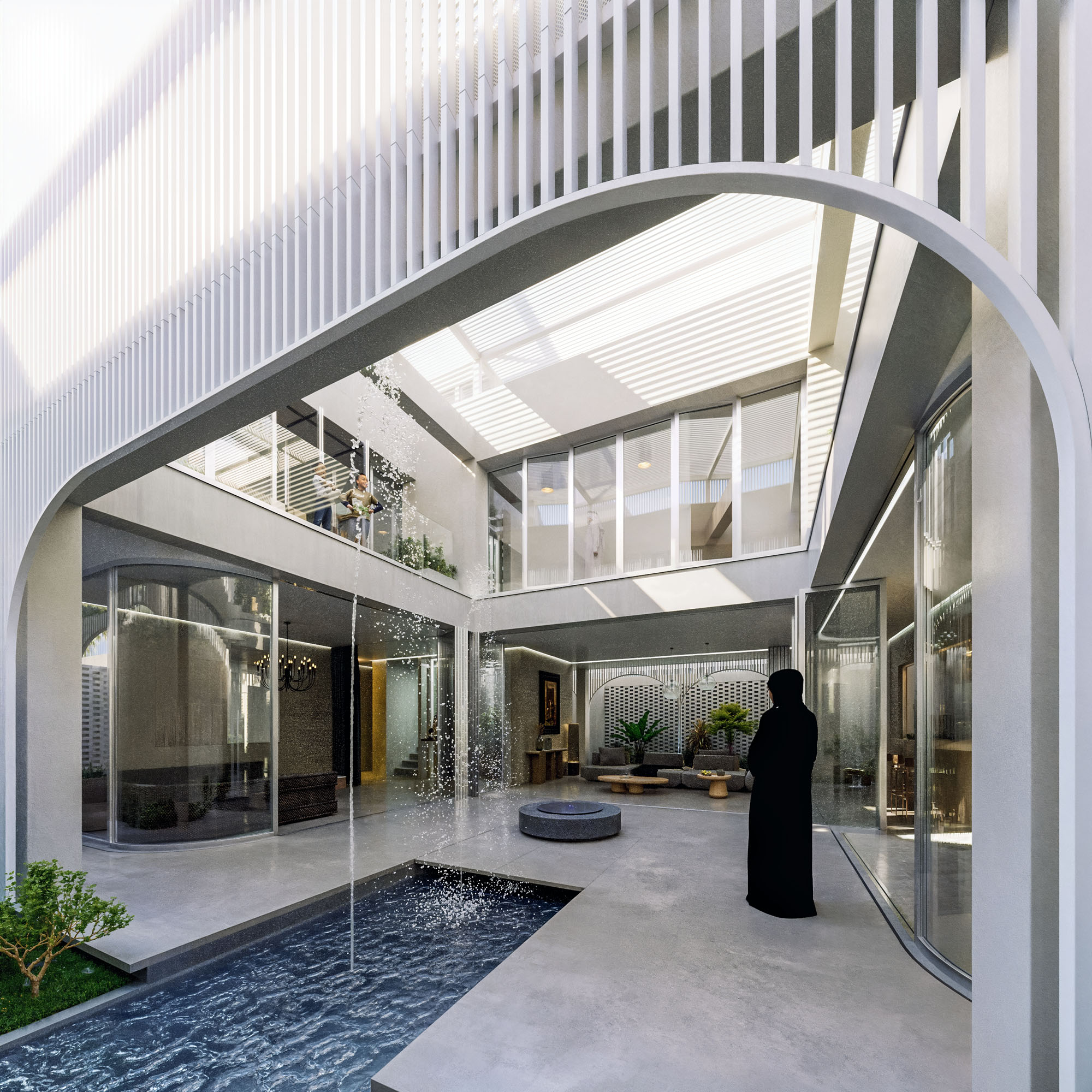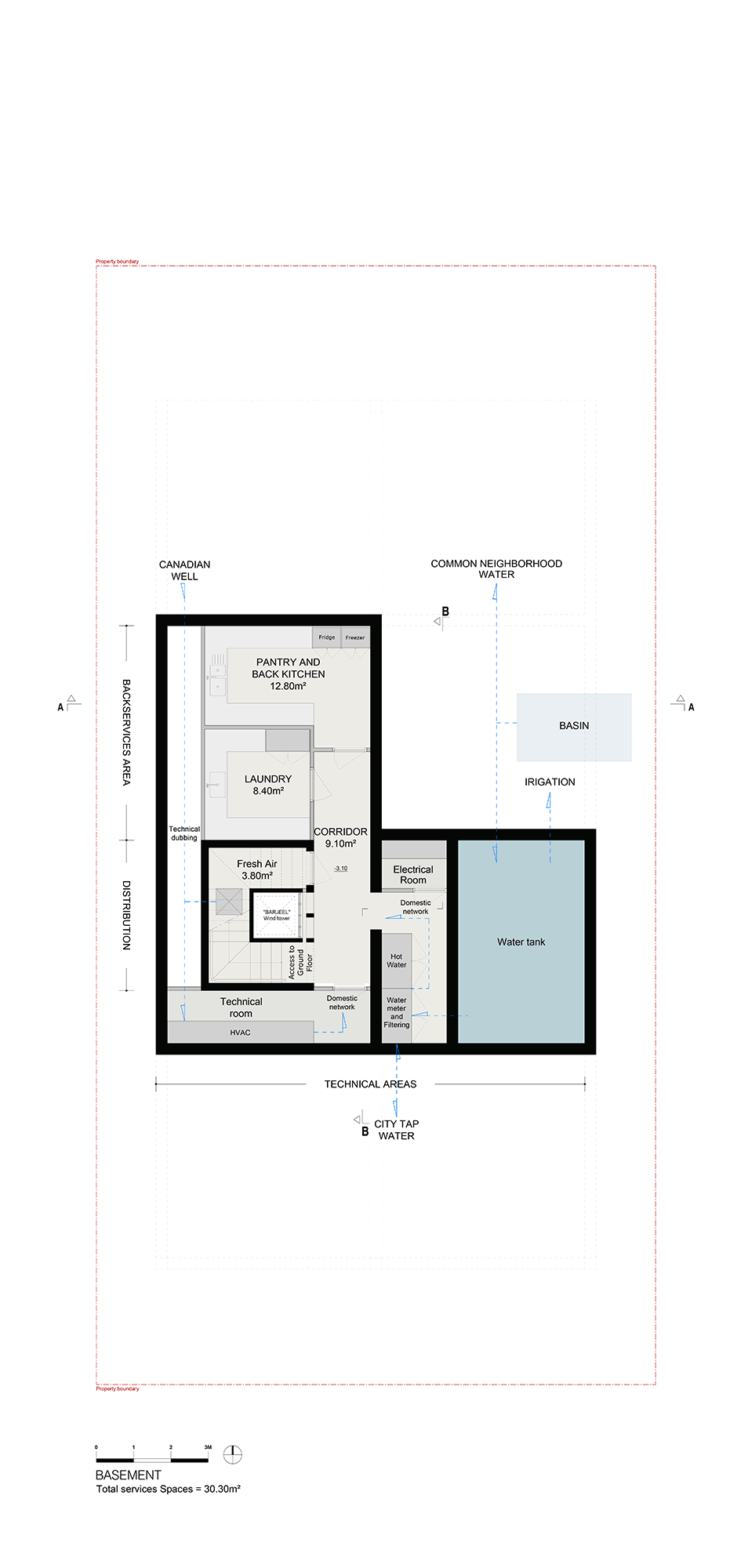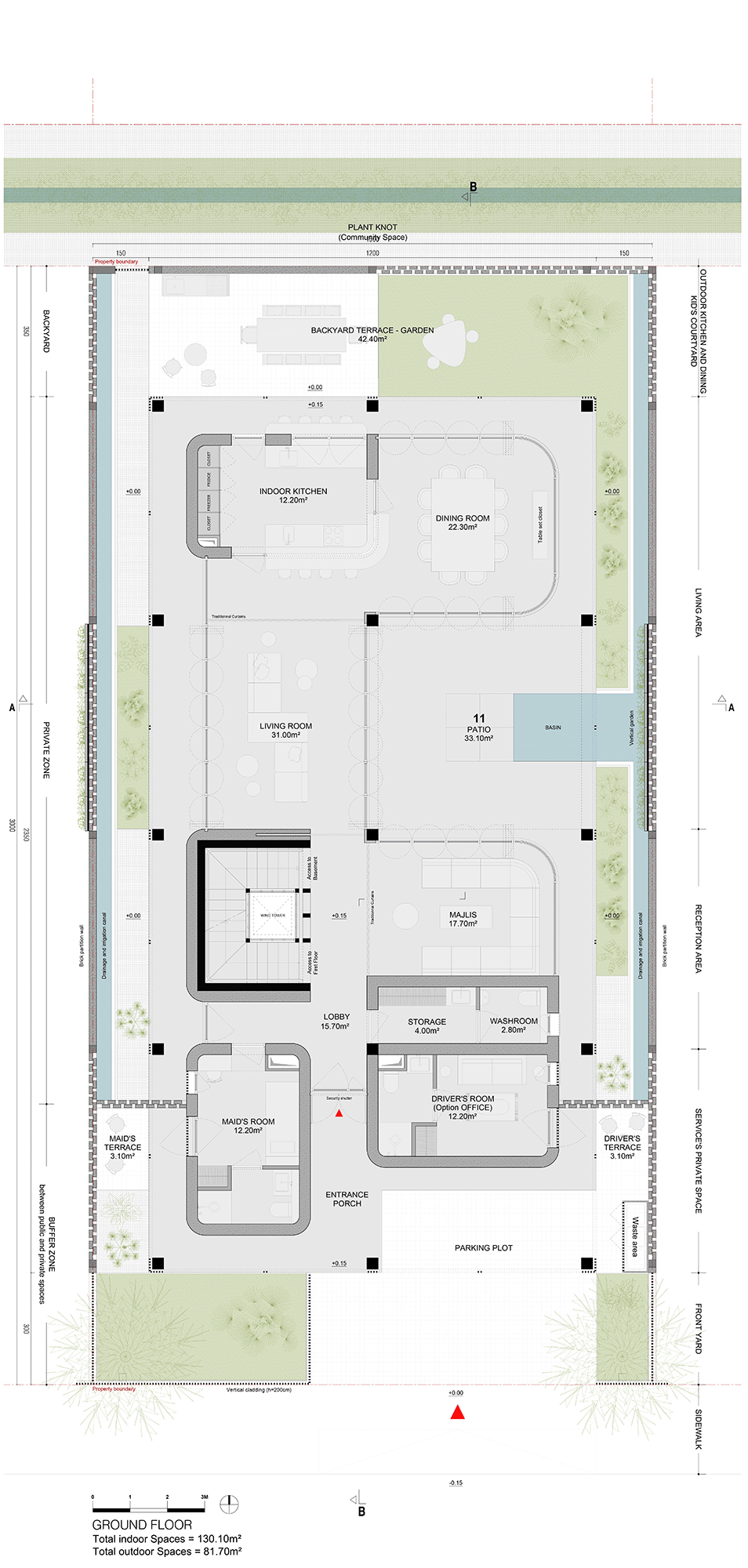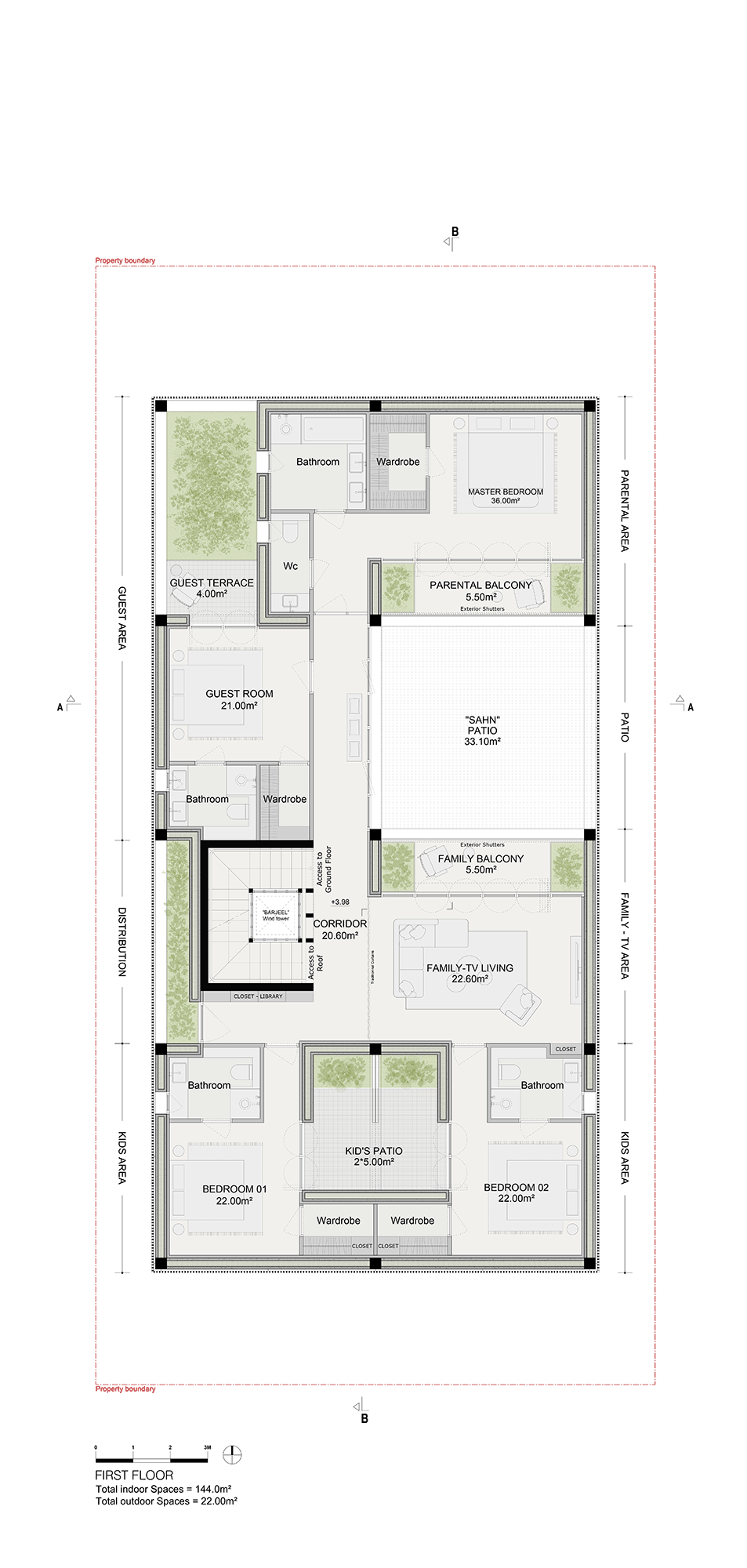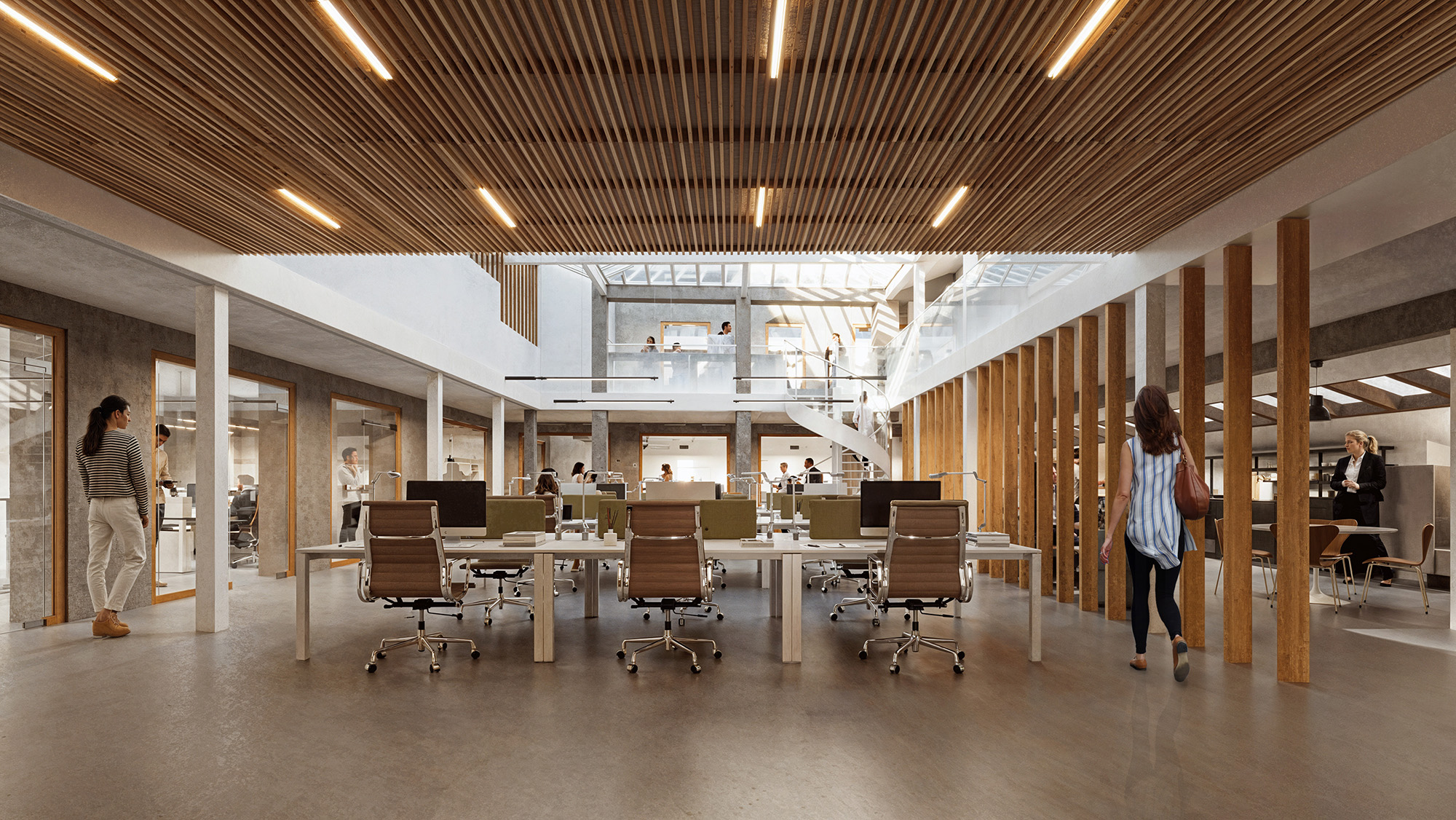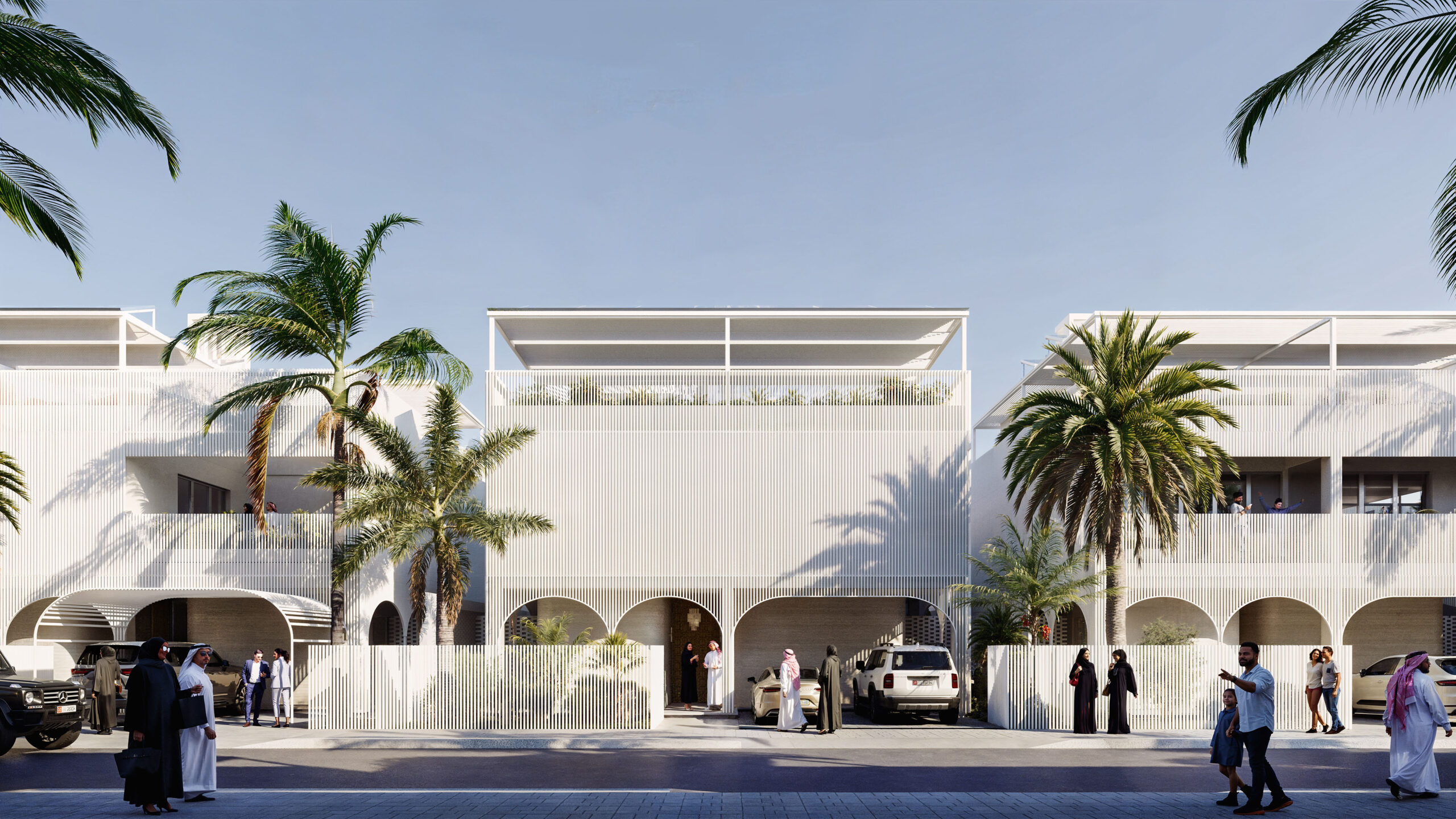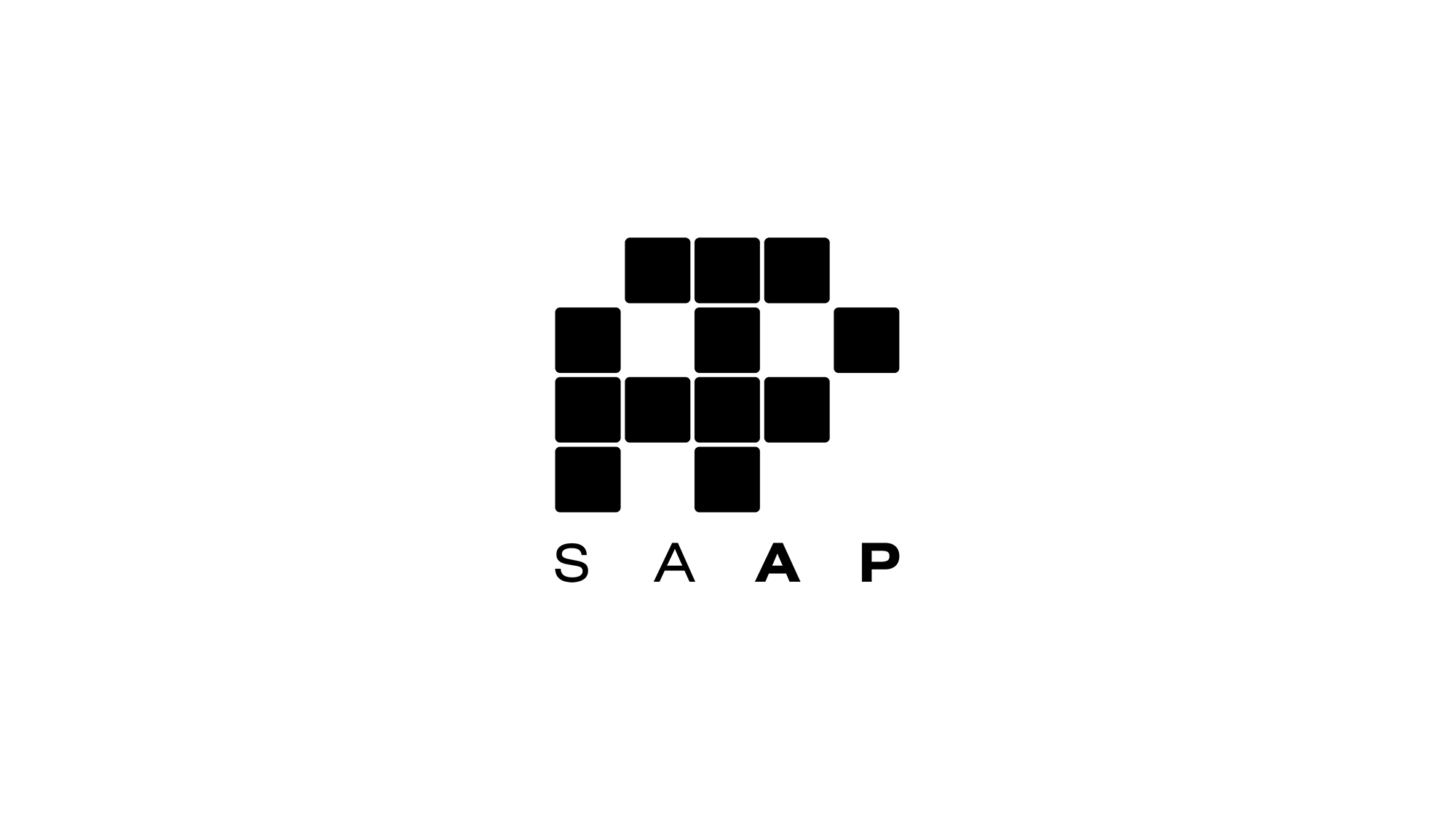– Fay’ – The Veil of Shade
Typology: Modular family house prototype
Location: United Arab Emirates (urban / peri-urban context)
Climate: Arid desert (BWh – Köppen classification)
Surface area: 280 m² to 420 m²
Status: International competition – Buildner “House of the Future” 2024–2025
Target client: Local families, pilot projects, urban research
Objectives: Modularity, climate resilience, affordability, scalability
Team: SAAP Architecture – Aodren Antien, Géraud Pizon
Context & Intent :
Fay’ – The Veil of Shade is a prototype of residential housing designed for contemporary Emirati families.
It responds to a call for ideas launched by the government of the United Arab Emirates as part of the Mohammed Bin Zayed Residential Housing Programme, aimed at developing accessible, durable, and climate-resilient single-family homes, in harmony with cultural values, local lifestyles, and extreme environmental conditions.
Conceived as a realistic and replicable solution—both at the domestic and territorial scales—the house is intended for large-scale deployment through public aid schemes, land grants, or interest-free financing models.
Fay’ combines energy efficiency, modularity, and cultural grounding in a sober yet ambitious architecture, designed to adapt to social transitions and the climate challenges of the 21st century.
Fay’ — meaning “the cast shadow” in Arabic — is a house that speaks the language of the desert, where shade is not merely a shelter, but a sacred, structuring presence, and the foundation of a new way of life.
Inspired by vernacular Islamic architecture, it draws on ancestral wisdom to craft a resolutely contemporary response—adapted to extreme climates and evolving lifestyles.
Its climatic envelope — the Fay veil — merges environmental performance with spatial symbolism. Galleries (riwaq), filtered screens (mashrabiyas), inner courtyards (sahn), and wind towers (barjeel) compose a passive system for shading, ventilation, and cooling.
• The riwaq, a covered peripheral gallery, offers shaded circulation while connecting the home to the garden and the neighborhood. It integrates a nahr (water channel) that allows runoff and enhances cooling through evaporative flow.
• The sahn, a large central courtyard, is cooled by a salsabil — a basin and fountain — where water gently flows over planted walls and troughs, creating a microclimate through evaporation.
• The mashrabiya, a perforated filtering screen, becomes a double bioclimatic skin made of wooden slats, recycled aluminum and perforated sheet metal — protecting façades and roofs while letting air and light through.
• The barjeel, a hybrid wind tower, captures and channels breezes into each room. Its efficiency is amplified by cooler ground-level air, refreshed by vegetation, garden moisture, and the cascading effect of water runoff.
At peak heat, localized misting systems (on the roof, in patios or along walkways) can be activated to enhance thermal comfort — without relying on heavy air conditioning.
Fay’ reinterprets these elements with both restraint and precision. It offers a modular, resource-efficient, and climate-adapted home — blending spatial poetry, structural rigor, and environmental consciousness.
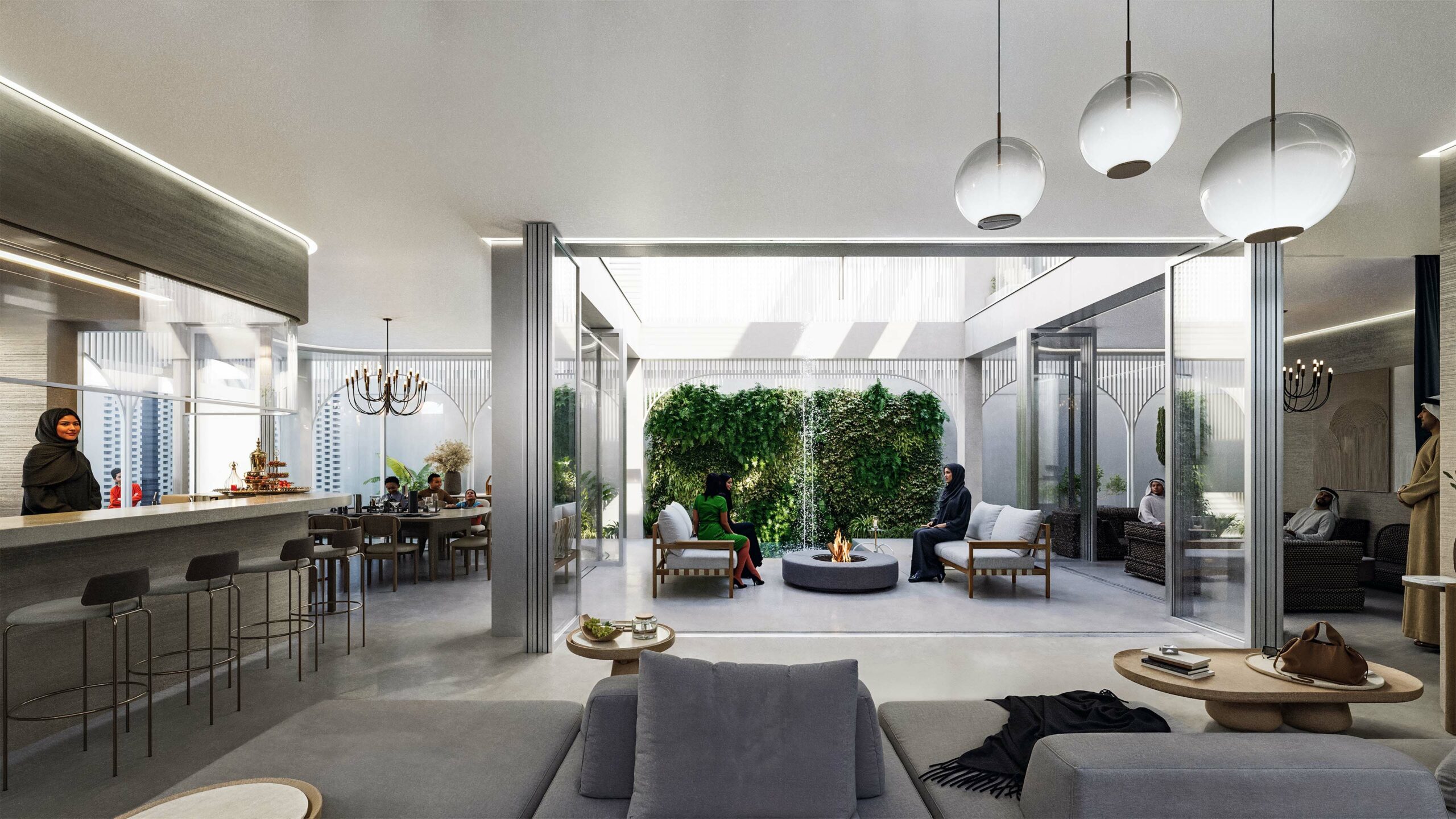
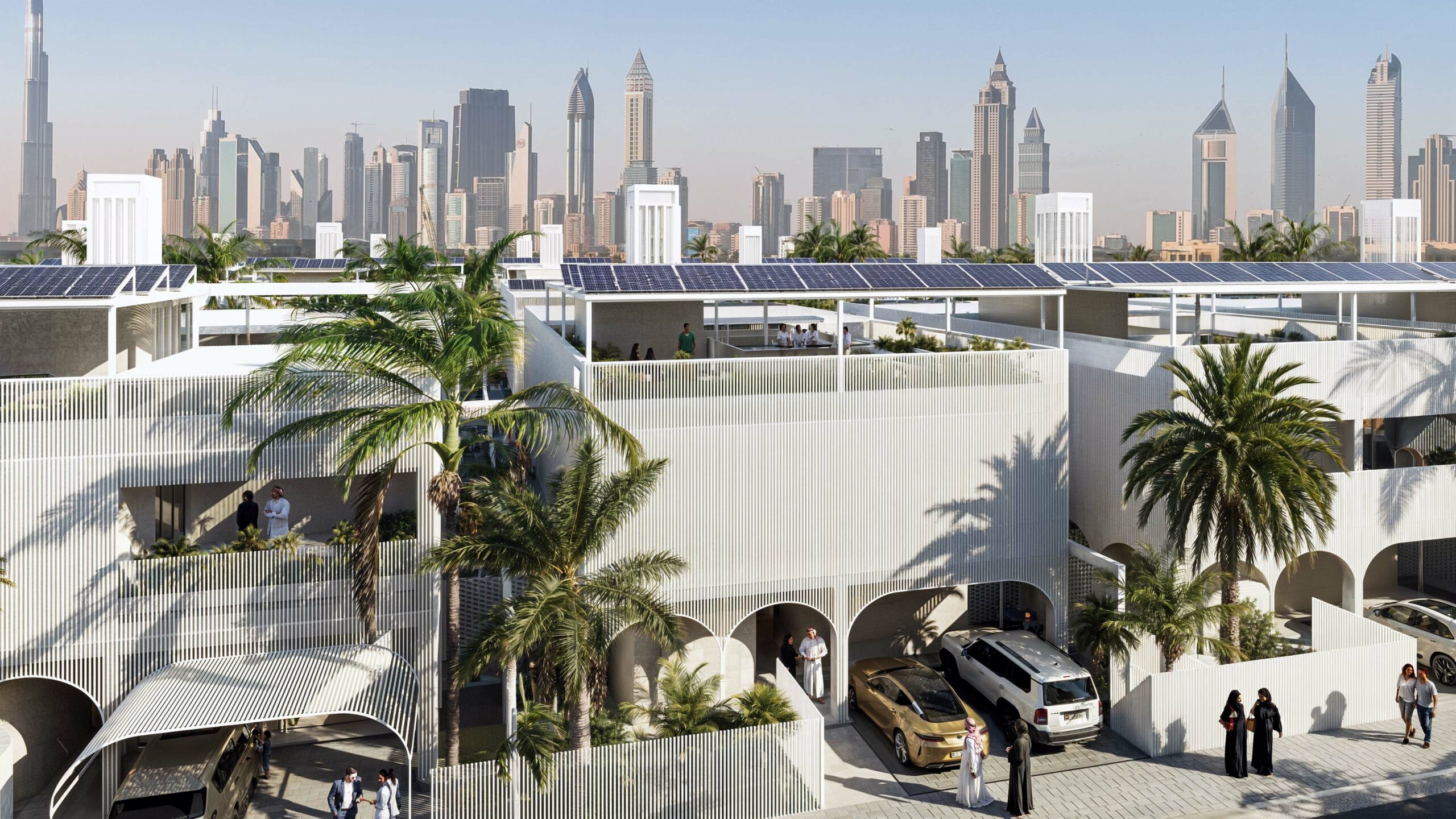
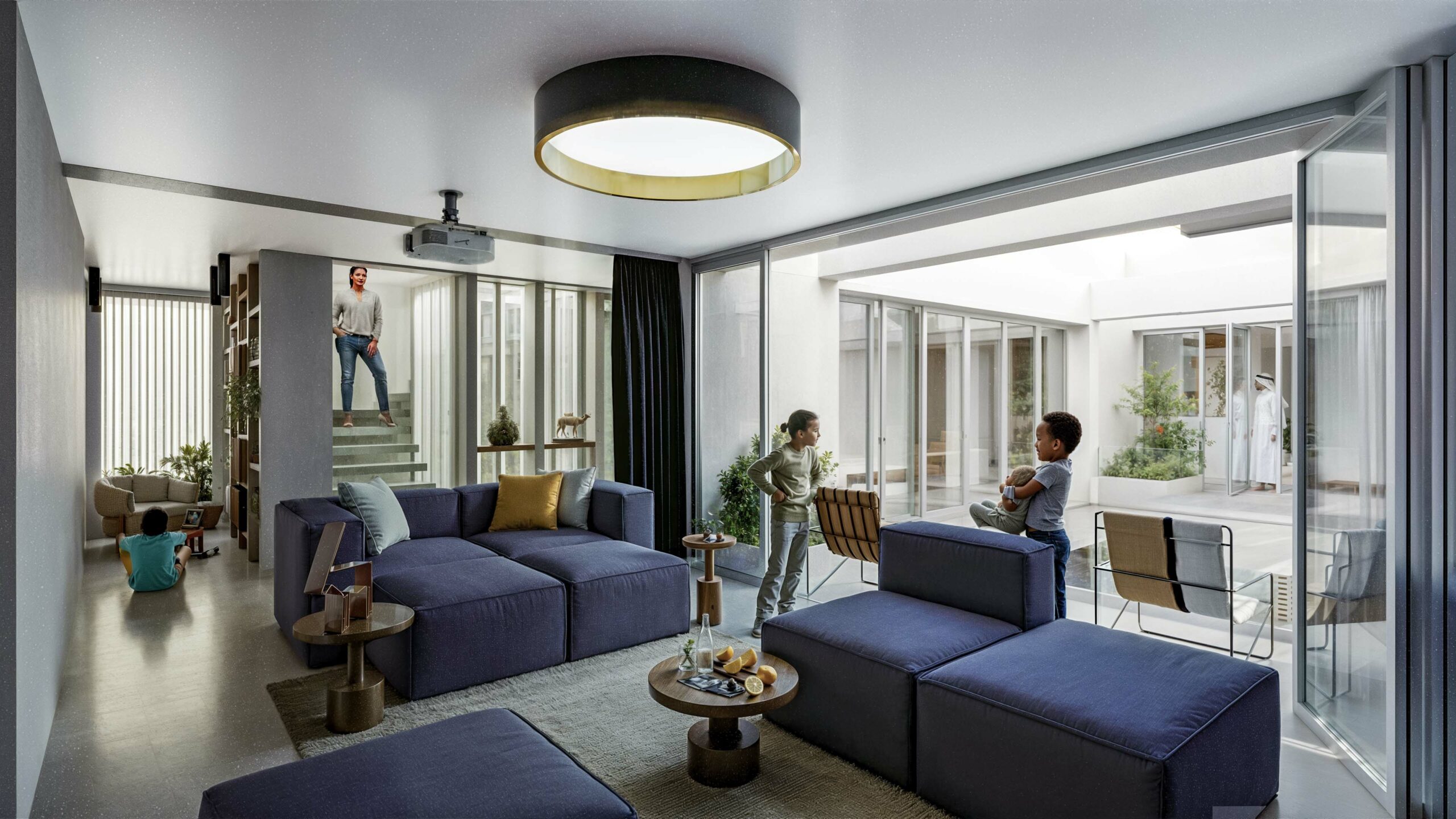
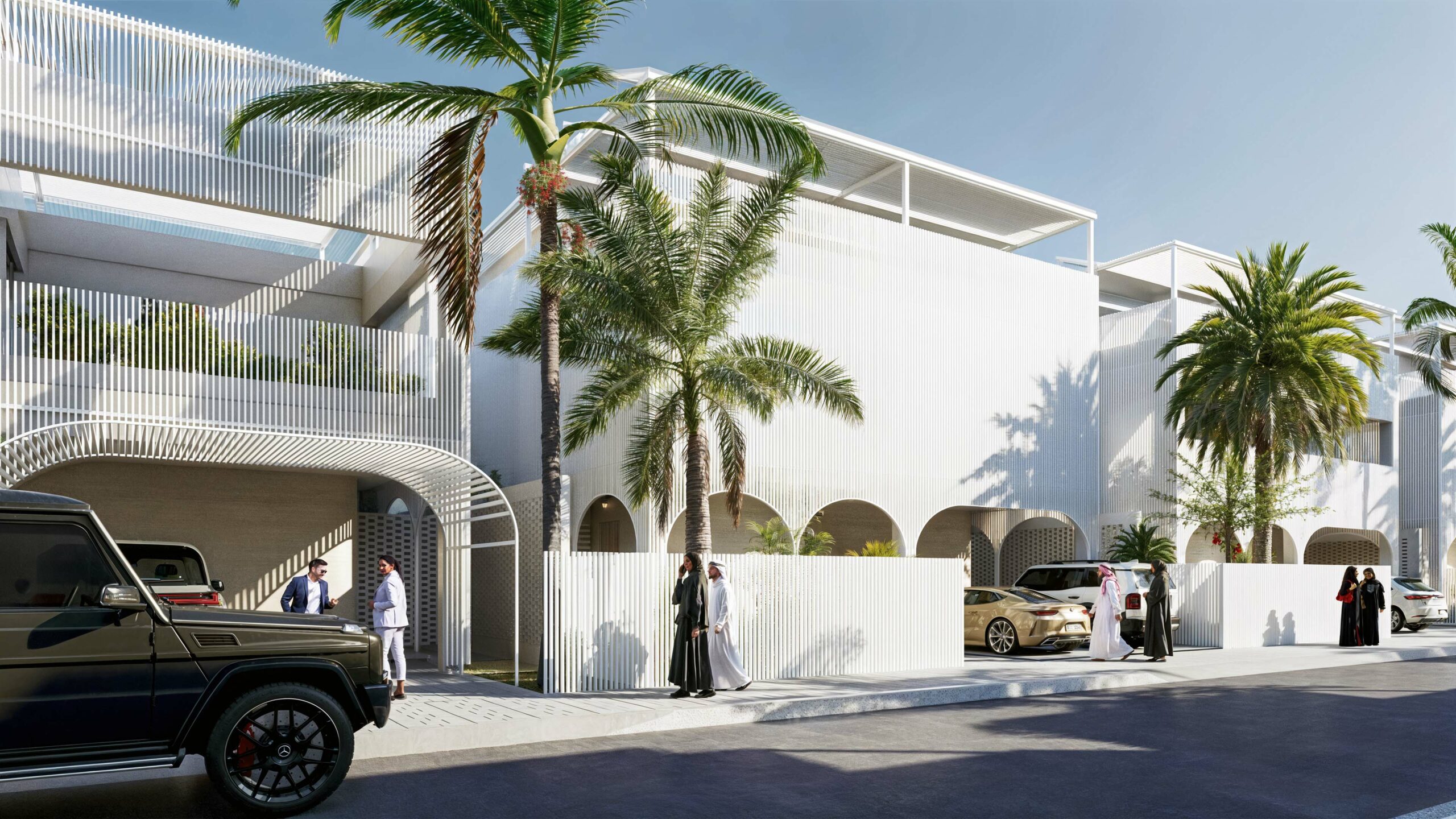
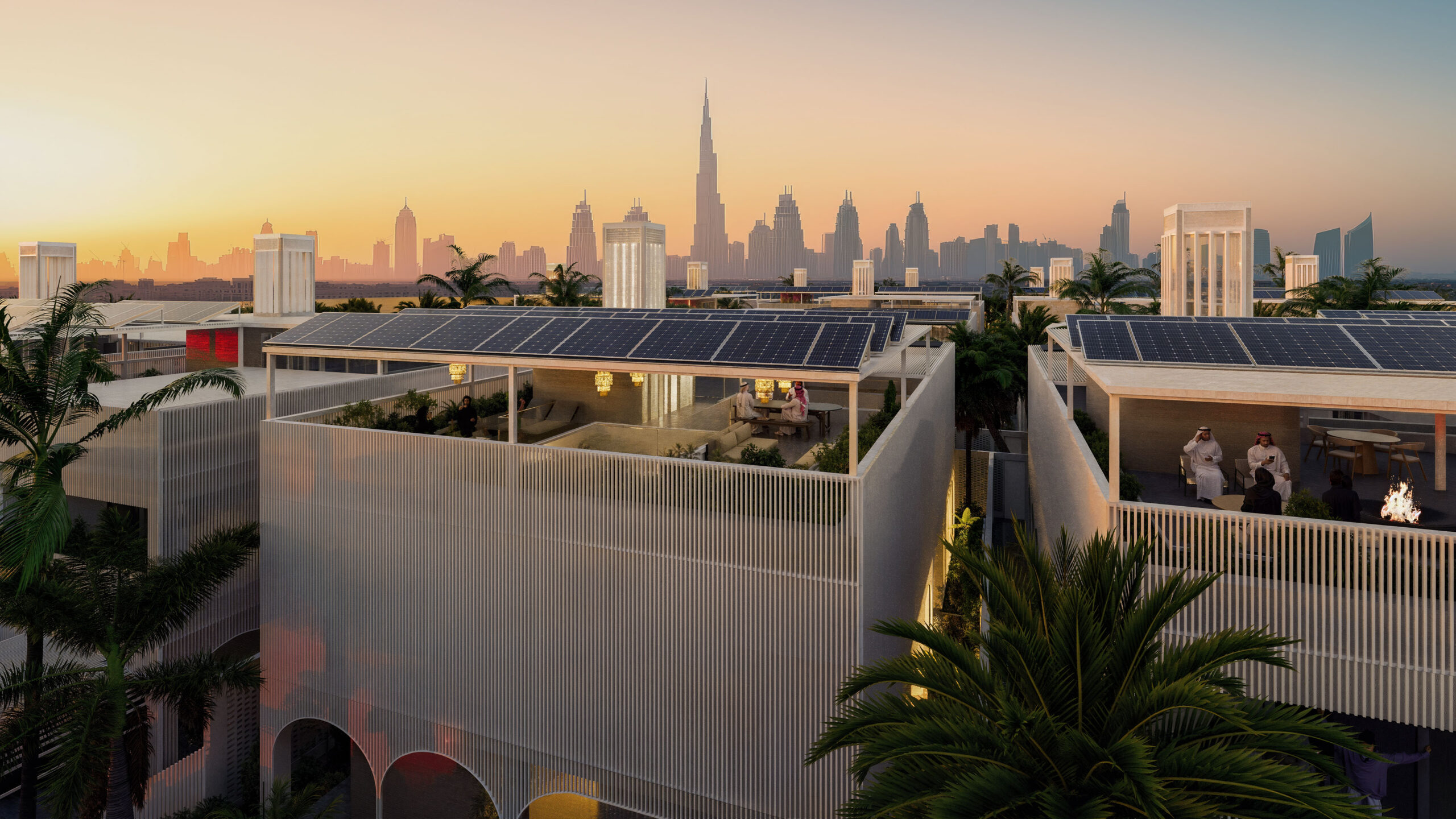
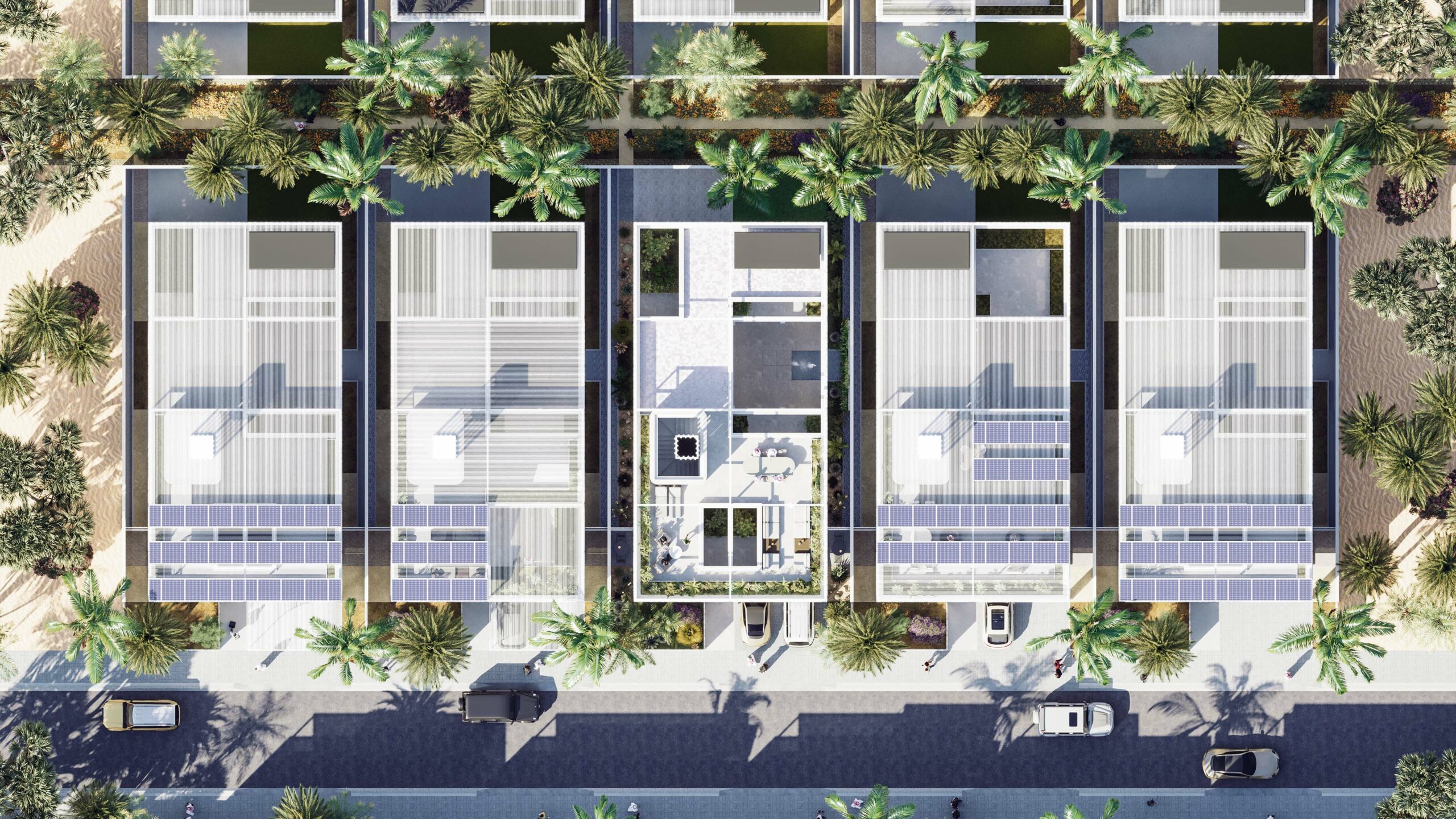
Concept & Use: A Home for All Seasons
• Open Plan & Seasonal Living
The ground floor is entirely free of structural constraints, thanks to a repeated modular grid (6×6 / 3×3 / 2×2 / 1×1) that concentrates load-bearing elements and liberates the living space. This flexibility allows for full opening to the outside from mid-October to mid-April through a single repeated pivoting bay system.
During the hot season, the living areas remain enclosed yet luminous: the cantilevered upper floor, arcade-like galleries (riwaq), and vegetation naturally filter the light without blocking ventilation.
Facing the street, technical rooms and staff quarters form a protective buffer, while ensuring functional autonomy.
• Quincunx Night Block
Upstairs, each bedroom includes an en-suite bathroom, dressing room, and a private terrace with no direct views onto neighbors.
Privacy is ensured by staggered orientation, filter walls, strategic planting, and mashrabiyas.
Cross-ventilation is enabled through opposing openings and air circulation corridors.
Le plan peut être facilement reconfiguré pour ajouter des chambres ou agrandir les terrasses, selon les besoins (extensions, évolutions familiales, accueil temporaire…)
• Central Family Room
This private living space anchors the upper floor, connecting the bedrooms around a rooftop patio.
It serves as a playroom, media room, guest bedroom, wellness space, or shared office — embodying the home’s intergenerational flexibility and conviviality.
• Majlis & Inhabited Threshold
As the counterpoint to the Family Room, the Majlis holds a strategic position at the entrance.
It welcomes guests without crossing into the family’s private sphere.
It can be made entirely independent with acoustic curtains and sliding panels, and includes a cloakroom and ablution facilities.
This semi-public threshold reinterprets a key tradition of Emirati hospitality: not everyone enters the home, but everyone is welcome at the Majlis.
• Inhabited Roof & Winter Kitchen
The roof becomes a seasonal living space, ideal for enjoying the night breeze or gazing at the sky.
Below, the winter kitchen extends domestic functions toward a mineral garden, combining lush vegetation where the view allows, with dry landscapes in the background.
An open terrace enables cooking and sharing with family even during the shoulder seasons.
“The open plan is reinterpreted with environmental intelligence — a spatial generosity made possible by climate-driven technology.”
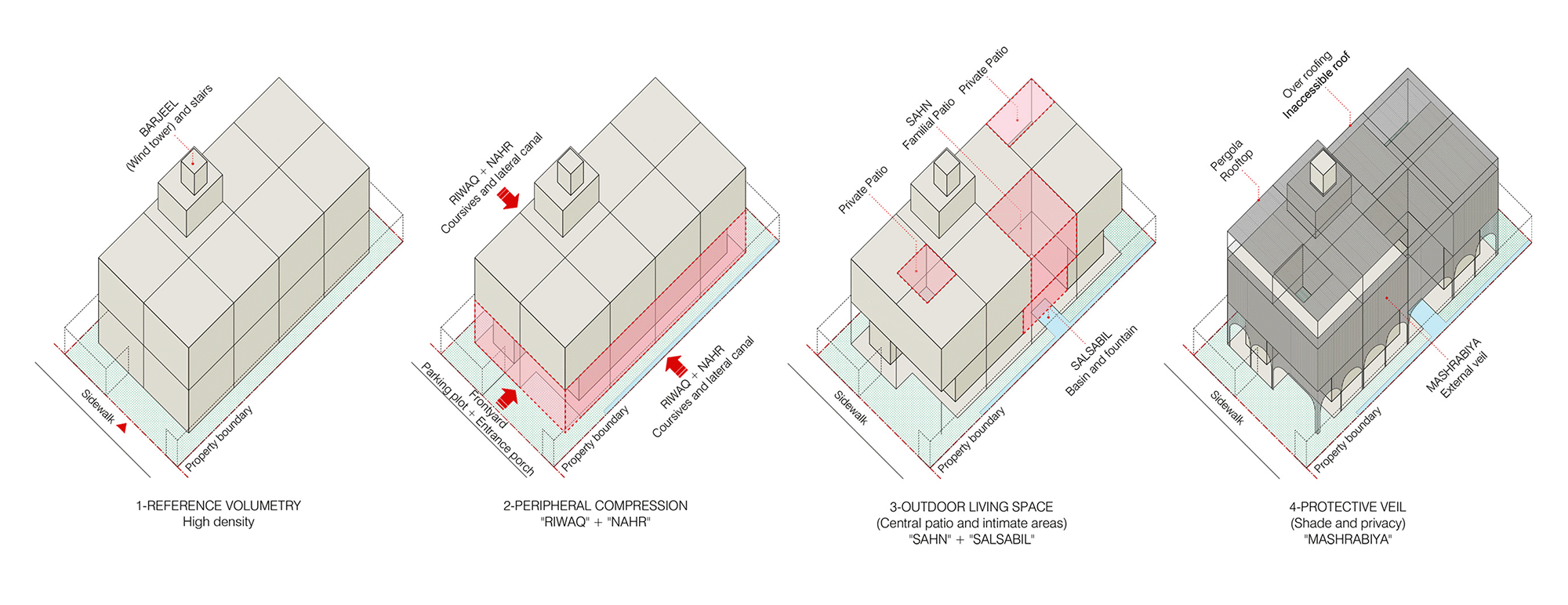
Construction system & material strategy :
Smart standardization for enhanced performance
• Repetitive modular grid
6×6 m → 3×3 m → 2×2 m → 1×1 m
→ A “pixel” logic to compose every space, from patios to furniture.
• Standardized openings
1 pivoting glass panel model
1 door type
1 window type
→ Repetition = cost control + formal clarity
• Prefabricated elements
– Precast concrete frames
– 3D-printed panels
→ Integrated insulation + local dry sand
• Low-impact, bio-based materials
– Compressed earth foundations
– Low-carbon concrete
– Natural clay and lime plasters
– Permeable paving with crushed oyster shells
• Raw yet refined finishes
→ No decorative surplus – only essential, noble materials
→ Budget reinvested into passive/active environmental performance
• Cost-saving and scalable
→ Fewer elements, more coherence
→ Simplified design logic and seamless extensions
“It’s not minimalism — it’s precision: stripping away the superfluous to invest in what matters.”
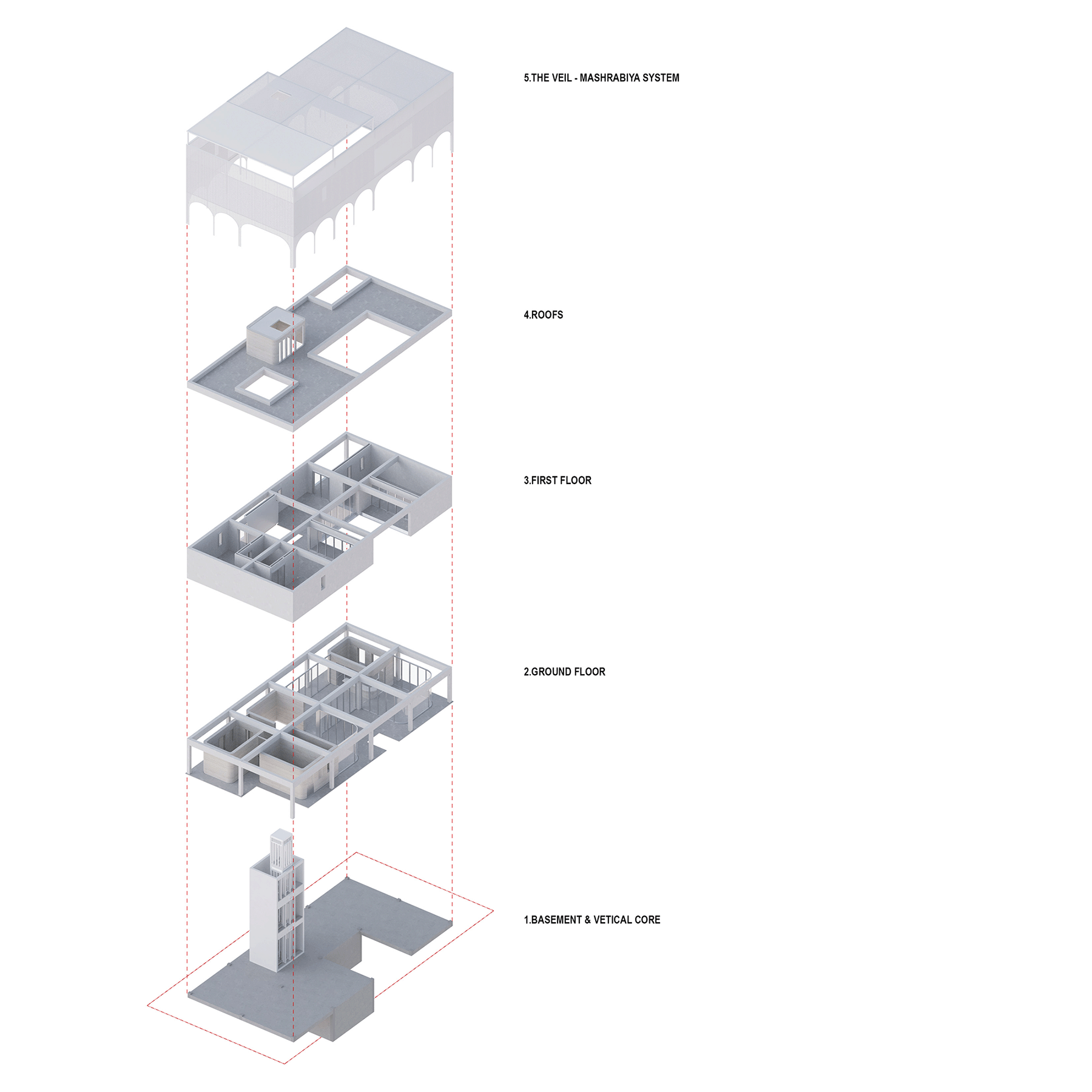
Modularity & Adaptability :
• A home designed to grow with life: expand, adapt, welcome.
• Modular and standardised structure allowing vertical or lateral extensions without demolition.
• Fully reconfigurable spaces: sliding partitions, acoustic curtains, open or enclosed rooms depending on needs.
• Multiple integrated uses: remote work, home care, independent housing, temporary studio.
• An architecture that supports life’s changes — without ever constraining them.
Evolving family scenario
A couple moves in. A child is born. Then twins... Grandparents come to help.
The house adapts — a room becomes a bedroom, a terrace becomes a lounge.
Always the same house, but never the same life.
Integrated residential scenario
A shared home office turns into a guest room or care space.
The terrace transforms into a covered winter patio.
Architecture accommodates life’s shifts — without freezing them in place.
Collective or rental scenario
An independent studio for a student, a single parent, or a caregiver.
Option for subletting or temporary cohabitation.
"One house, many lives."
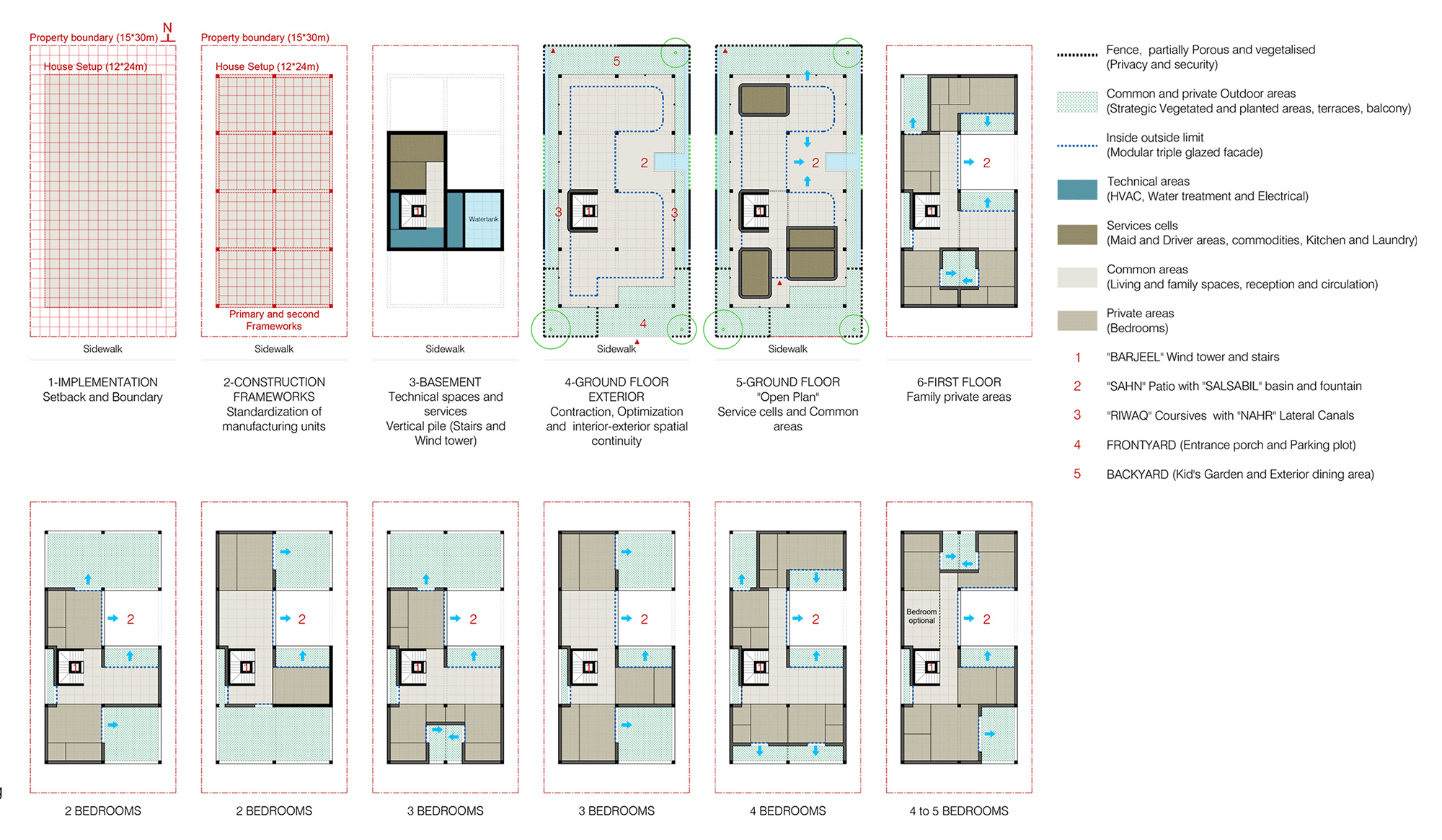
Environmental Intelligence: Systems & Synergies
Three major systems work in synergy at the scale of both the home and the neighbourhood:

Fresh Air Supply – Shared Earth-to-Air Heat Exchange (Canadian Well)
• Cooled air via underground piping using thermal inertia.
• Sand and particle filtration + discreet ground-level diffusers.
• Active assistance when needed (controlled ventilation).
• Strategic greening: green walls, condensation basins, misted roof surfaces.
Hot Air Extraction – Hybrid Barjeel Towers
• Passive cooling through chimney effect and wind towers.
• Discreet push-pull mechanical system when wind is absent.
• Room-by-room control based on use (passive preferred).
• Intelligent openings based on airflow, orientation, heat and sandstorms.
Water – Integrated & Circular Management
• Rainwater harvesting at both neighbourhood and household scale.
• Physical filtration + activated charcoal.
• Reuse for domestic needs, irrigation, and decorative fountains.
• Closed-loop option: phytopurification and aquaculture.
Integrated Environmental Intelligence
• Passive architecture: orientation, shading, natural ventilation.
• Thoughtful use: light, air, and energy triggered only as needed.
• Discreet technology: hybrid systems and local control.
• Anticipatory habitat: seasonal adjustment and targeted comfort.
“Fay’ is a building block within a micro-ecological infrastructure.”
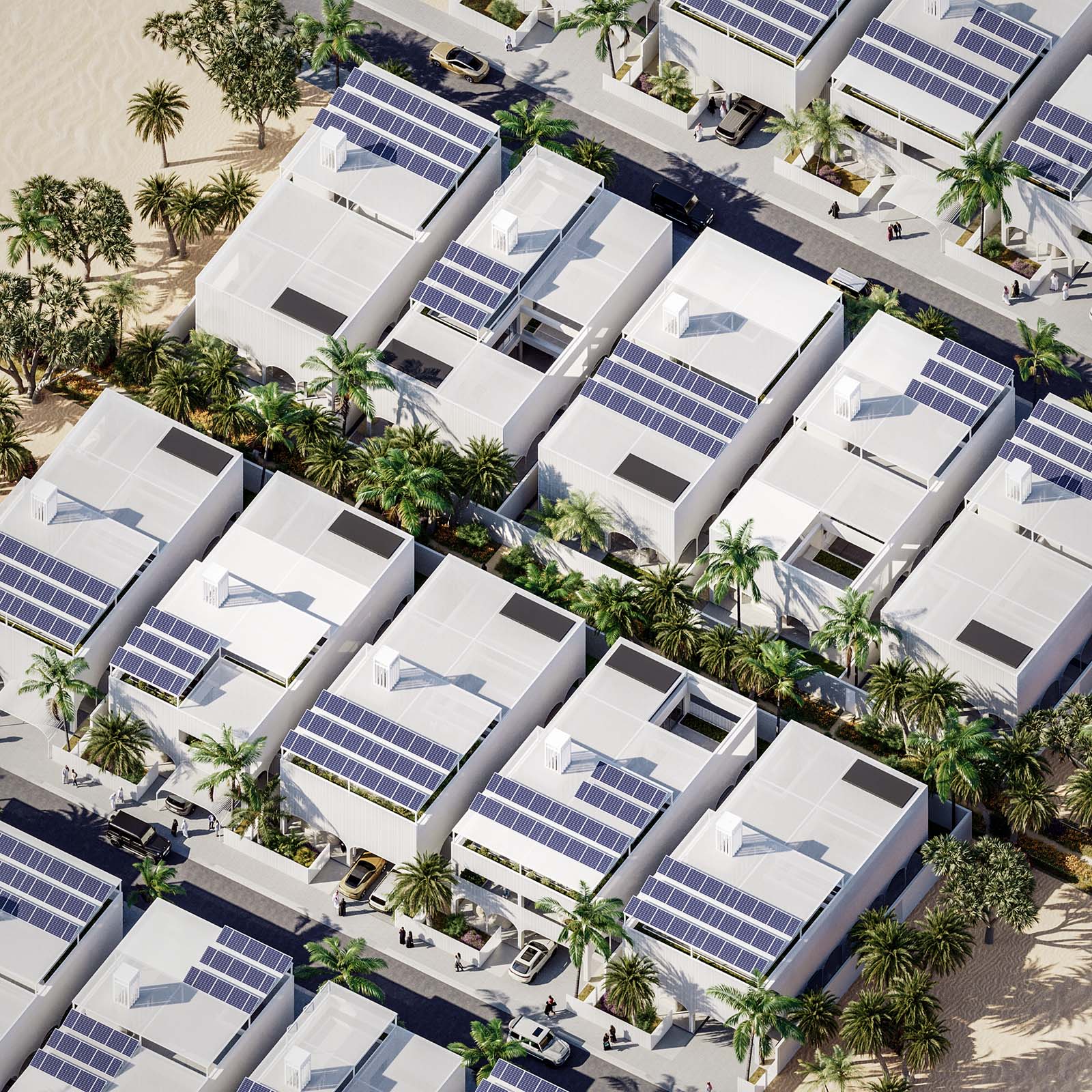
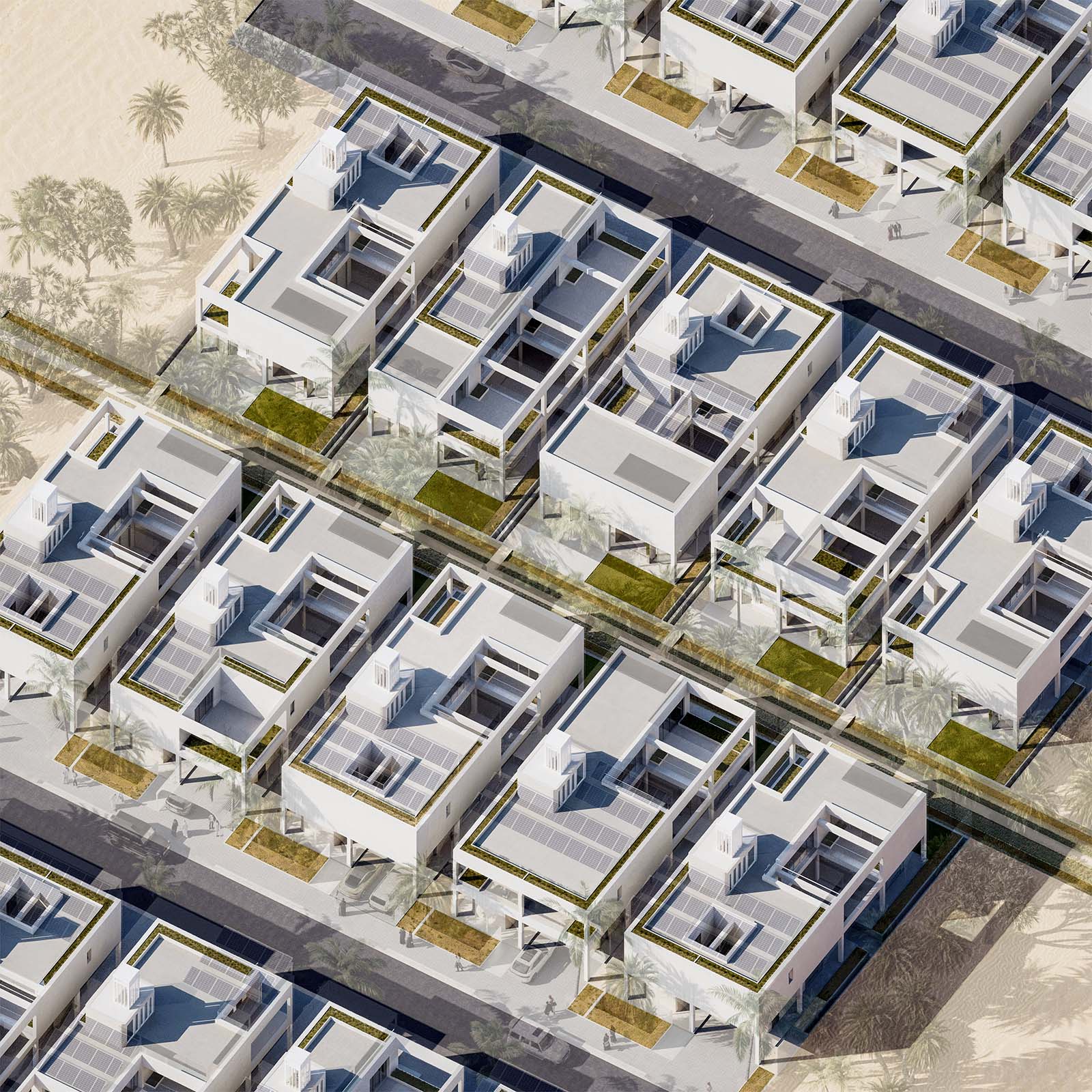
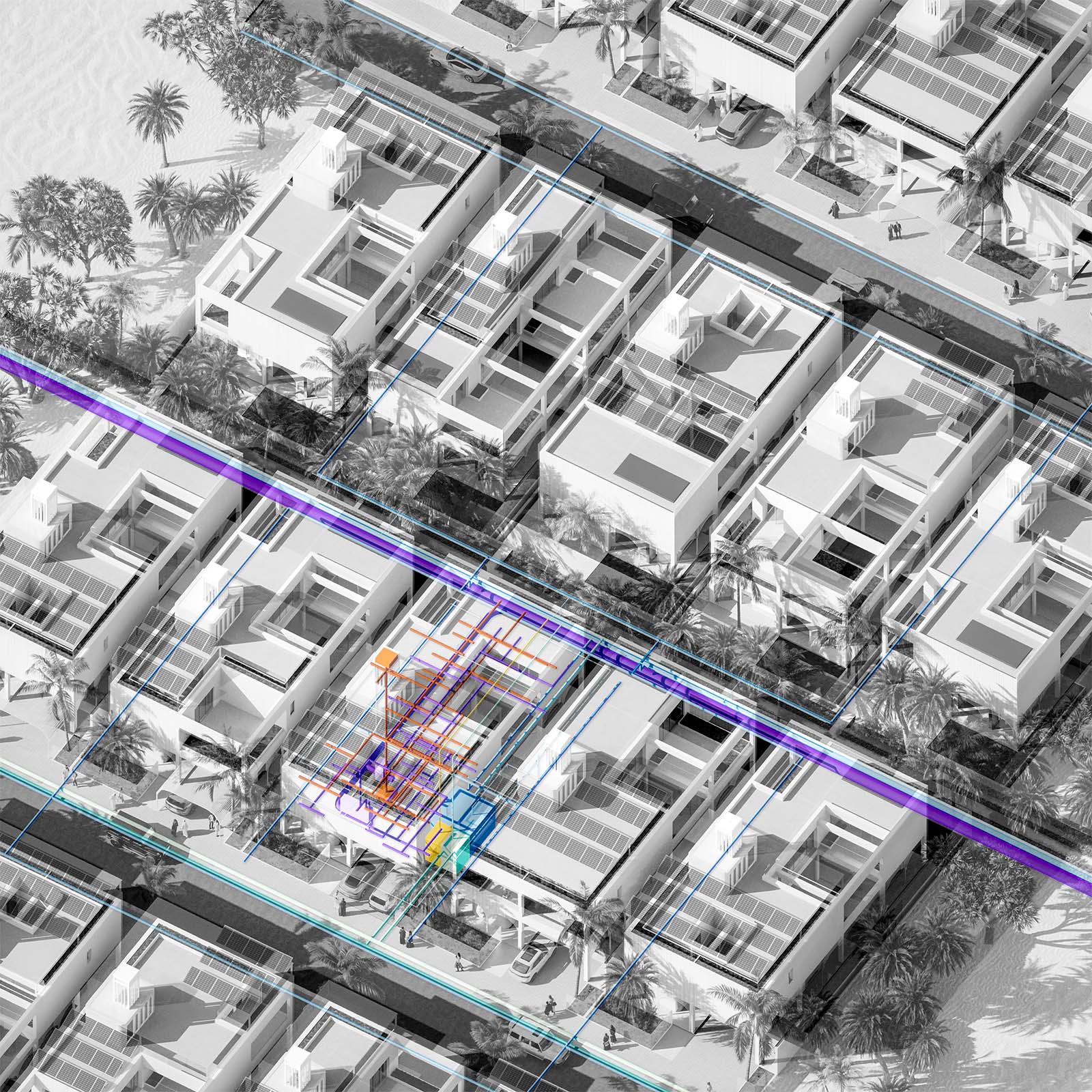
Urban Vision & Local Anchoring:
The project establishes a seamless continuity between domestic intimacy and the collective dynamics of the neighbourhood.
Perforated enclosures allow light and breeze to pass through while ensuring safety and privacy.
The non-orthogonal layout of plots avoids monotony and encourages a diversity of uses and spatial situations, echoing the spirit of traditional villages.
At the rear, a landscaped wadi structures public space around a vegetated and technical corridor.
It channels rainwater, enhances natural ventilation, and becomes a shared space for children’s play, neighbourhood gardens, and cool zones.
Each house becomes permeable without being vulnerable: it contributes to the life of the neighbourhood without compromising the residents’ privacy.
This interweaving of air, shade, and water forms a shared matrix — a sensory language spoken by all homes.
“It is through breeze, shade and water that homes speak to one another.”
Synthetic Environmental Strategy:
• Lumière & soleil
Shading sails, recessed arcades, filtered light through mashrabiyas, and light-coloured plasters help reduce overheating while ensuring soft, natural daylight.
• Ventilation naturelle
Optimal orientation, cross ventilation, barjeel (wind tower), chimney effect, mashrabiyas, patios and salsabil fountains combine to enhance thermal comfort.
• Gestion de l’eau
Ground retention and infiltration, partial greywater recovery, planted channels (nahr), passive misting, and humidification of patios and roofs on the hottest days.
• Matériaux
High thermal inertia structure, breathable envelope, perforated screens made from local wood and recycled aluminium, and rational prefabrication to reduce carbon footprint and simplify construction.
• Échelle urbaine
Irregular plots to avoid monotony, porous alignments and air corridors to ventilate the neighbourhood, layered planting, and a technical/landscaped wadi to guide air, water and community flows.
“A living neighbourhood, where each home contributes to a shared ecosystem.
More than technical optimisation, Fay’ orchestrates a climate.”
Integration Pathways & Related Technologies
Fay’ is not a standalone model, but a flexible component within a broader ecosystem.
Its approach can interact with a range of proven technologies and strategies in arid environments.
SAAP identifies several levers to enhance or extend the prototype at the scale of the building, the neighborhood, or the territory.
• Energy & Thermal Storage
Seasonal heat storage using sand (SandTES / Polar Night Energy)
Autonomous microgrids at neighborhood scale
Passive solar production + long-life solid-state batteries
• Water Cycle & Hydric Autonomy
Seawater greenhouses for freshwater through condensation
Atmospheric water harvesting (fog or dew collection)
Crescent catchments & soil regeneration (Al Baydha / Sahelian techniques)
Greywater filtration and reuse at housing or district level
• Recycling & Short Supply Loops
Local treatment of organic waste (dry compost, biochar)
On-site material recovery units (liquid waste, micro-factories)
Design for disassembly and materials reuse
• Bioclimatics & Regenerative Systems
Wind-tower-inspired ventilation systems (barjeel)
Filtering gardens and thermal buffers (roof gardens, passive greenhouses)
Agro-ecological integration: filtering gardens, productive roofs, mindful cultivation
• Desert Prototyping & Urban Systems
Experimental models like Masdar City or Sahara Forest Project
Compact urbanism based on wind, shade, and thermal inertia
Masterplans designed to generate active microclimates
“Fay’ acts as a connector. Each house becomes an open cell, able to evolve, to host, to produce or to recycle — serving a sustainable, collective, and regenerative way of living.”

PRINCIPLES
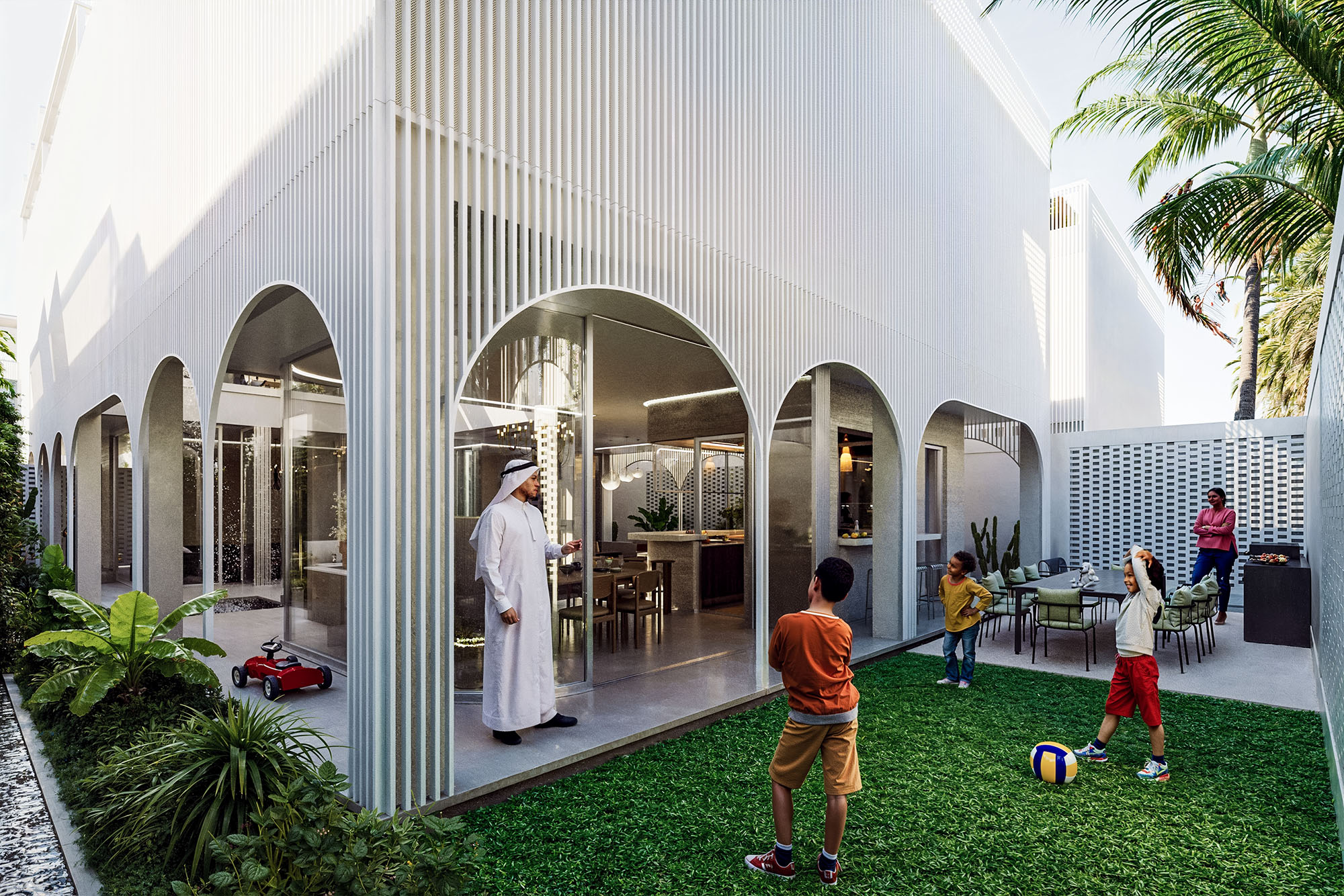
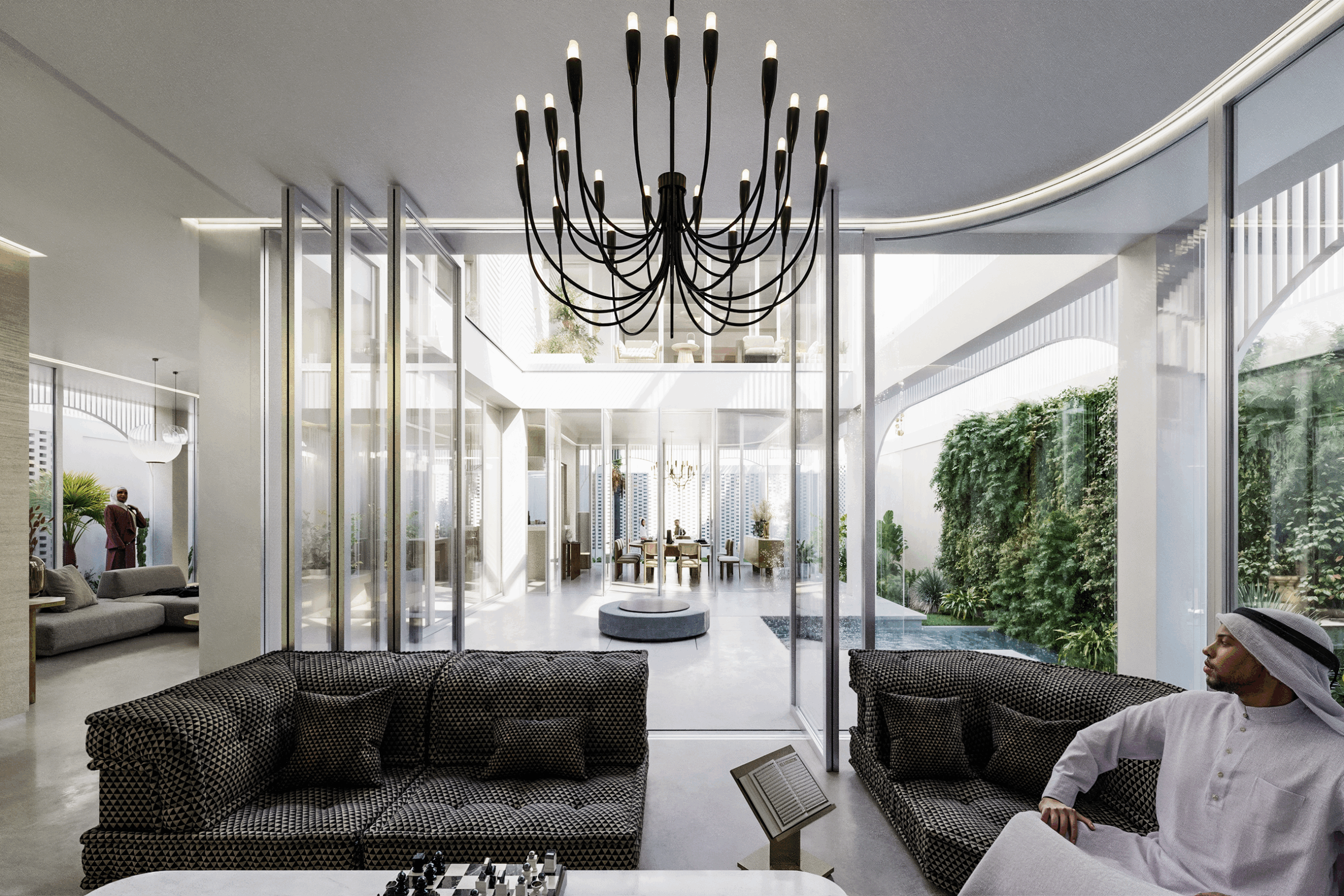

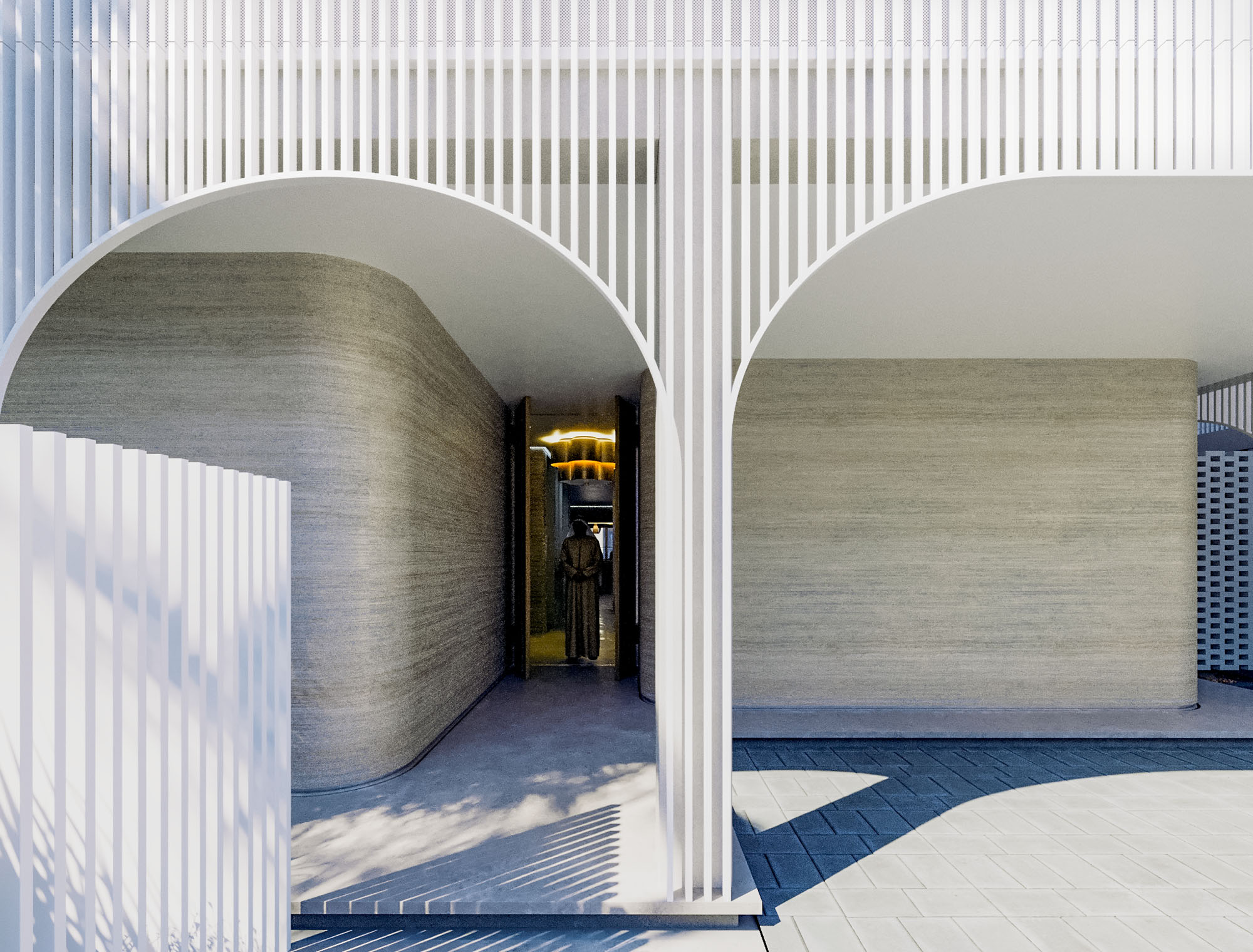
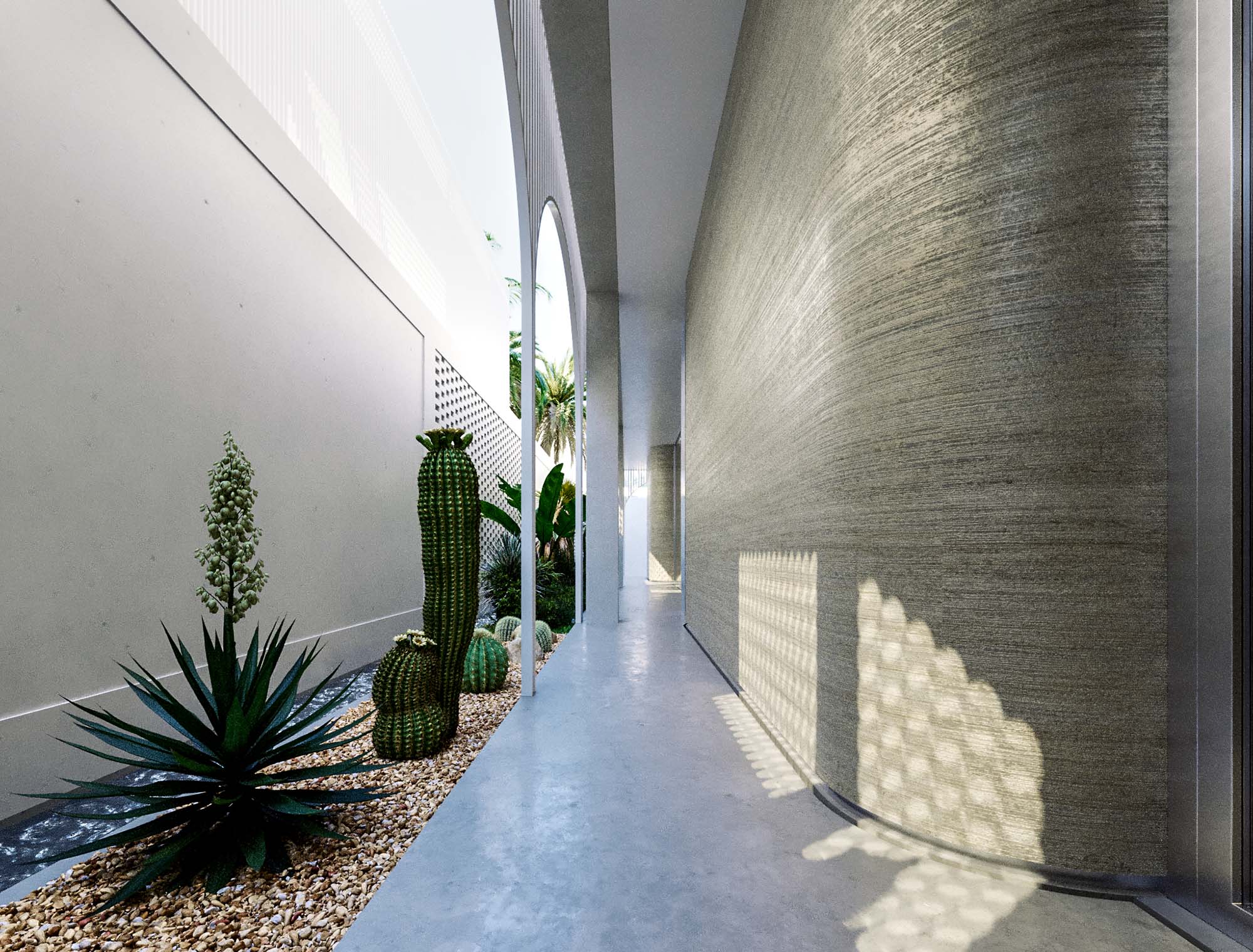
Fay’ vs Traditional Housing :
Aspect
Layout
Climate
Water
Construction
Global Cost
Adaptability
Traditional Housing
Fixed, compartmentalised
100% air-conditioned
Centralised network
On-site masonry
High + continuous consumption
Inflexible
Fay’
Open and flexible
Passive + hybrid systems
Rainwater recovery & reuse
Standardised prefabrication
Reduced through repetition
Evolves with lifestyles
Towards Implementation :
Although precise cost estimates depend on local data, the project strategy aims to:
· Significantly reduce long-term consumption over 5–10–20 years (cooling, water, energy);
· Reinvest savings into spatial quality and shared living uses;
· Offer a replicable model at both plot and neighborhood scale;
· Enable phased implementation: a central core first, followed by extensions as needs or means evolve.
Indicative budget estimate: based on a standardized construction strategy targeting a 20–30% reduction in costs compared to traditional construction methods — for equivalent surface area and comfort.
The integration of advanced passive/active climate systems may represent an additional cost of approximately +20%, largely offset over 20 years by near-zero energy consumption (especially for cooling and water).
Target budget range (competition reference): between AED 800,000 and 1,000,000, depending on selected options (solar modules, extensions, environmental automation…). This envelope aligns with the feasibility objectives of the House of the Future program initiated by the UAE.
Lastly, the project may qualify for national funding schemes (land grants, sustainable construction subsidies) or interest-free Islamic financing dedicated to climate-resilient housing — supporting the financial accessibility of the prototype over the medium and long term.

Towards a House of the Future…
Rooted in the land, shaped by culture, guided by the needs to come.
"Designed for today’s deserts, Fay’ may well offer answers for tomorrow’s cities."
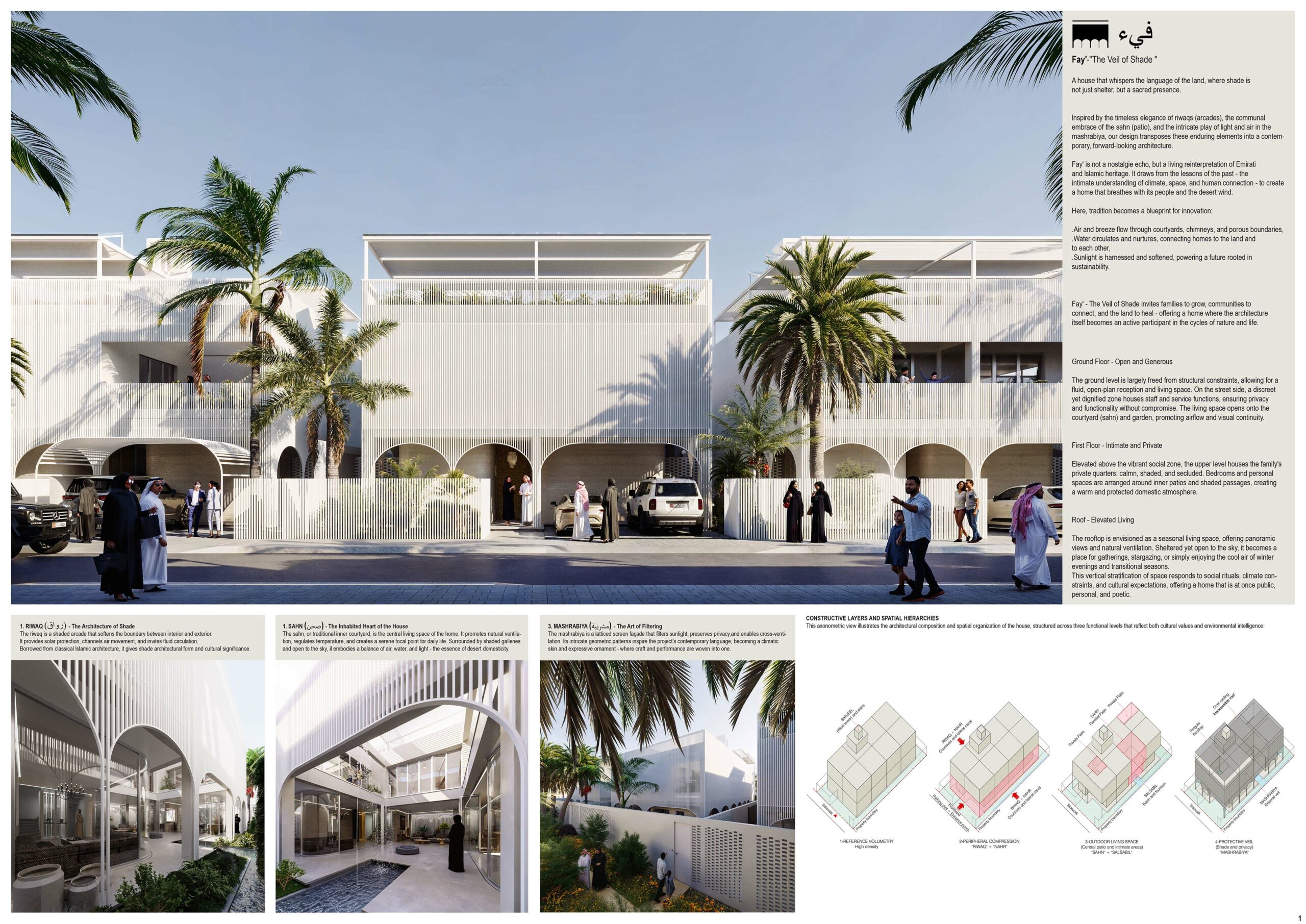
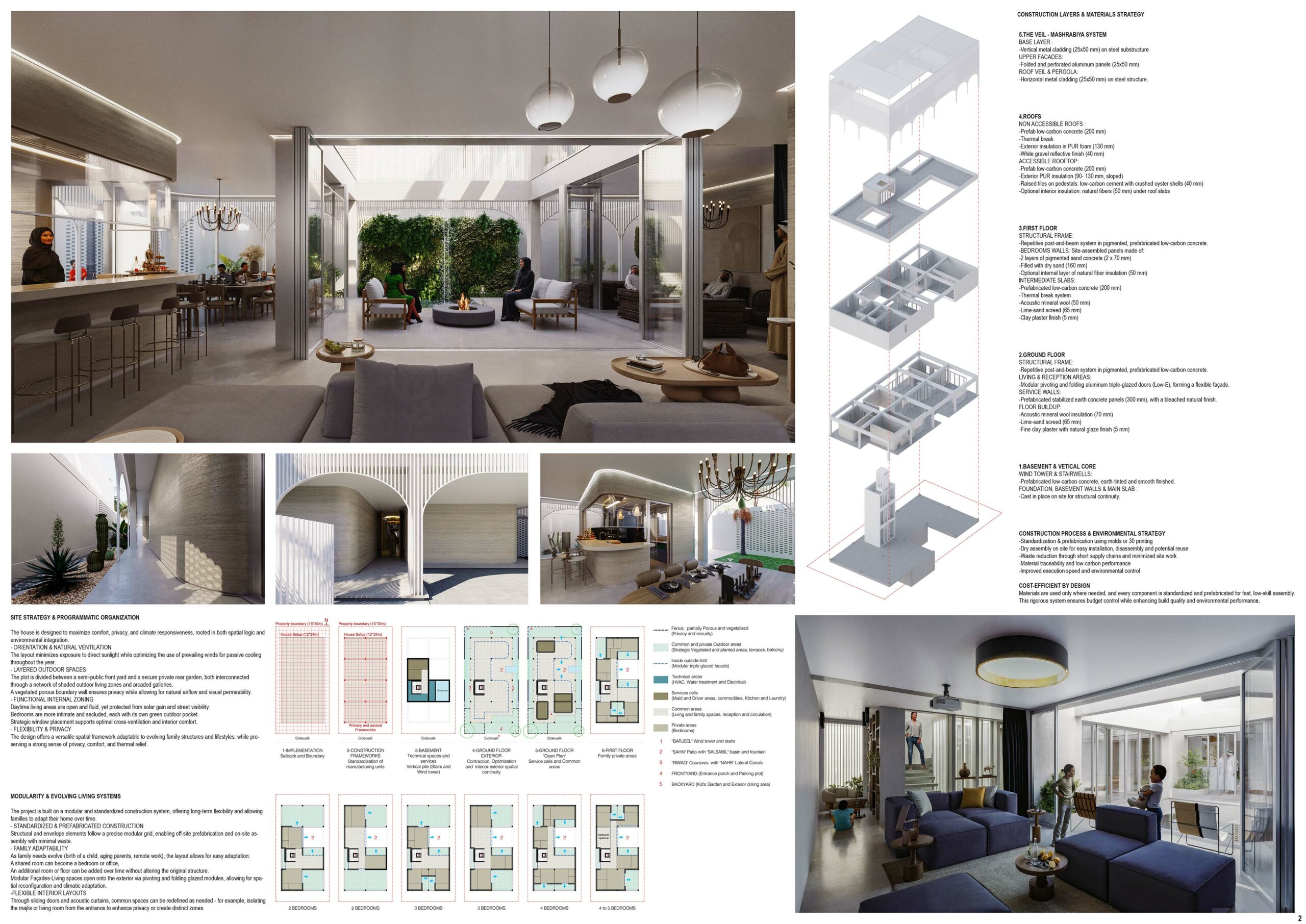
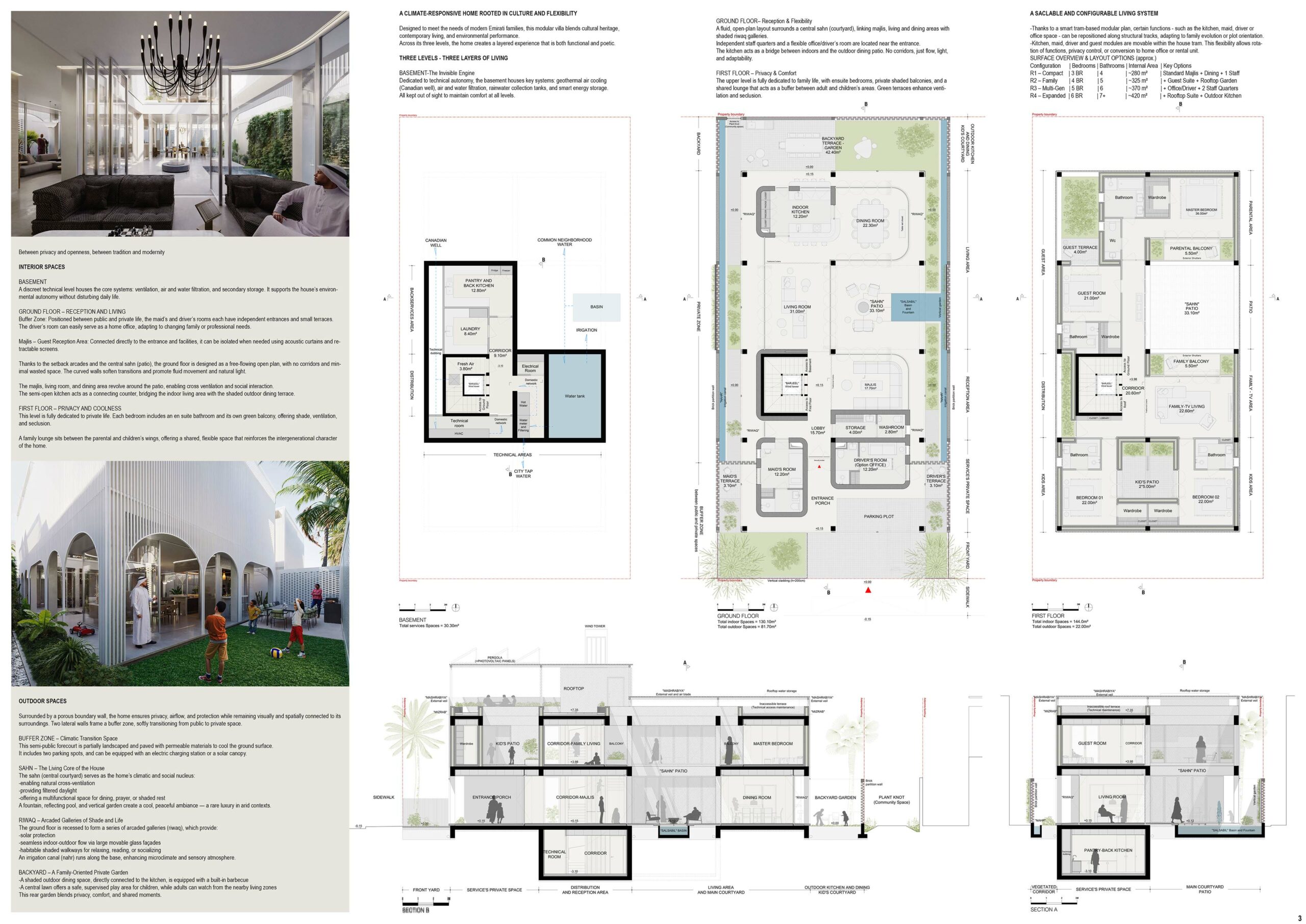
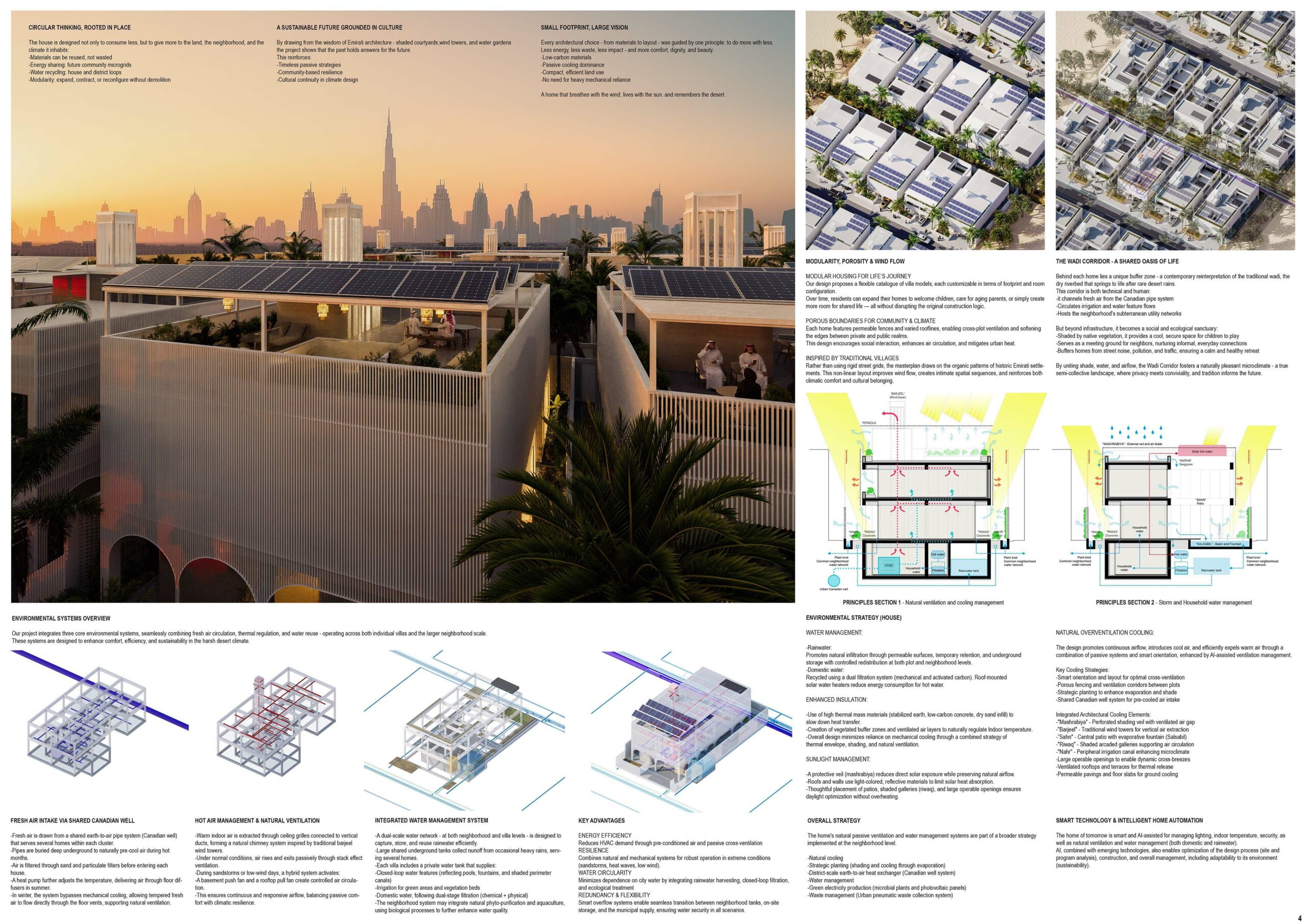
COMPETITION PANELS
Jury Review — Buildner
The project Fay’ – The Veil of Shade was praised by the jury of the House of the Future 2025 competition as one of the most ambitious proposals — both poetic, technically grounded, and deeply contextual.
It received excellent scores in the graphic and narrative evaluation, demonstrating strong consistency between the concept, architectural choices, and clarity of presentation.
Excerpts from the Jury Review, July 2025: , juillet 2025:
“Fay’ is one of the most radical projects — both poetic and technical. It is not just a house, but a system for living.”
“Its understanding of seasons and domestic uses is remarkable — the architecture breathes with the climate.”
“The concept is ambitious yet perfectly controlled. The project offers a new way of inhabiting arid climates.”
Project submitted to the international competition “House of the Future” – Buildner / UAE 2024–2025
– Featured in the Research section of SAAP Architecture
– To be shared on LinkedIn / Instagram / Archilovers upon official publication

